Stan Garfield's Blog, page 16
May 26, 2023
The Five Cs of KM: Create, Part 1 — Basics, Connection, and Methods

This begins the fifth and final series on knowledge management in special libraries and information centers, structured around Five Cs: Capture, Curate, Connect, Collaborate, and Create. This four-part blog post series is about the fifth C: Create.
Creating new knowledge is an important goal for most organizations, but it can be challenging to achieve. By creating explicit processes that use existing forms of knowledge flow to create new knowledge, innovation can be stimulated, and invention is facilitated. Creative ideas can be developed into useful new products, services, and ways of getting work done.
BasicsIn The Knowledge-Creating Company, Ikujiro Nonaka wrote:
“In the knowledge-creating company, inventing new knowledge is not a specialized activity — the province of the R&D department or marketing or strategic planning. It is a way of behaving, indeed a way of being, in which everyone is a knowledge worker — that is to say, an entrepreneur.”
“New knowledge always begins with the individual. A brilliant researcher has an insight that leads to a new patent. A middle manager’s intuitive sense of market trends becomes the catalyst for an important new product concept. A shop-floor worker draws on years of experience to come up with a new process innovation. In each case, an individual’s personal knowledge is transformed into organizational knowledge valuable to the company as a whole. Making personal knowledge available to others is the central activity of the knowledge-creating company. It takes place continuously and at all levels of the organization.”
In Putting Ideas to Work, Tom Davenport, Larry Prusak, and Bruce Strong wrote:
“Under old approaches, organizations often didn’t manage knowledge creation in any formal way. They left it to their research-and-development or new-product groups, which weren’t that familiar with the process because they were focused on the creation of products, not the underlying knowledge necessary to develop them.”
“The organizations with the best knowledge-creation programs define in advance the type of information they need and why they need it — say to improve customer service or to develop easier-to-use products. They solicit ideas, insights and innovations from rank-and-file workers, customers, and business partners, rather than relying solely on the R&D staff to come up with the ideas. Technologies such as internal corporate blogs and wikis…are encouraging this broader participation in knowledge creation.”
Knowledge creation includes inventing and innovating new concepts, approaches, methods, techniques, products, services, and ideas that can be used for the benefit of people and organizations. Creating new products and services, coming up with new ideas to try out, and developing innovative methods and processes can help transform an organization. Generating new sources of demand, stimulating personal and organizational growth, and rethinking the existing rules of the road can help an organization develop, thrive, and endure. Failure to do so may lead to stagnation, decay, or death.
Knowledge management can help trigger the imagination by providing a continually replenished source of ideas and experiences. People help bring out the best ideas in each other through their interaction in communities and networks. Publishing white papers stimulates creative thinking. Analyzing collected knowledge reveals patterns and opportunities for new developments.
Many organizations would like to be known for their innovations, but it is not easy to turn this aspiration into reality. The best ways to support knowledge creation are to establish standard processes for connecting creative people to one another, developing new methods, managing ideas, publishing white papers, and discovering new patterns through analysis.
ConnectionNew knowledge is often created through people interacting. A good way to enable such interaction is through communities and Enterprise Social Networks (ESNs). Community members engage in online discussions in which they learn from one another and build on each other’s ideas. They also participate in community events, such as giving and listening to presentations on community calls, providing advice in peer assists, and conversing in knowledge cafés.
Those who join threaded discussions in communities bring a wide range of experiences, perspectives, and opinions. When they bounce ideas off each other, the result is often a synthesis of the collective thinking that advances the total body of knowledge. When they share their work and their thinking in the community, it can spur advances and new ideas in response.
Regularly inviting innovators to present their latest ideas and inventions during community events can become a process of creation. As part of such presentations, build in time for community members to brainstorm about ways to apply the concepts. Suggest that good ideas be pursued, and then follow up on them during future events.
If your organization supports invention, a process for disclosing patents can connect inventors to other creative people. When an idea for an invention is shared with others, it can lead to helpful suggestions for improvements, colleagues who can act as a sounding board for testing assumptions, and connections to others doing similar work for ongoing collaboration.
MethodsKnowledge creation occurs when practical experiences are turned into new standard methods. Provide a process for practitioners who discover improved ways of doing things to convert their insights into new methodologies. This will result in new knowledge being provided to others.
Methods are repeatable techniques and approaches that can be used to solve a problem or accomplish a desired result in the best possible way. To create new methods, start by identifying gaps and opportunities that exist. What is a needed methodology that is currently unavailable? Is there an opportunity that could be pursued if only the right method existed? Find the people who have tackled relevant problems and developed new solutions and capture their practical experience. Transfer that knowledge into a new method.
For example, in a video library, it may be difficult to locate a specific passage in a recording. If you ask the staff to address this challenge, one staff member may have an effective way of searching the content of videos. You can document this approach and standardize it for use by the entire organization. Then the next time this need arises, there is a readily available and proven method that can be applied.
In Part 2 of this series, I will discuss ideas and white papers.
 The Five Cs of KM[image error]
The Five Cs of KM[image error]
May 20, 2023
George Siemens: Profiles in Knowledge

This is the 91st article in the Profiles in Knowledge series featuring thought leaders in knowledge management. George Siemens is an author, researcher, and theorist in the fields of learning, knowledge management, and technology. He focuses on connectivism, MOOCs, learning analytics, human and artificial cognition, and systems. He is the author of Knowing Knowledge, an important book not only for its content, but for the way in which it was written. He is based in Winkler, Manitoba, Canada and has multiple affiliations around the world.
Background ExperienceThe University of Texas at Arlington — Professor, 2013 — Present: exploring how technology impacts our humanityAthabasca University — Associate Director, Technology Enhanced Knowledge Research Institute (TEKRI), 2009 — Present: researching learning networks, social media, learning and knowledge analyticsUniversity of South Australia (UniSA) — Professor and Co-Director, Centre for Change and Complexity in Learning (C3L): researching networks, analytics, and human and artificial cognition in educationUniversity of Manitoba — Associate Director, Learning Technologies Centre, 2006–2009EducationPhD, University of Aberdeen, 2012: SustainabilityMA, Royal Melbourne Institute of Technology, 2007: Distributed LearningProfilesUniversity of South AustraliaCentre for Change and Complexity in Learning — University of South AustraliaWikipediaLinkedInEducation & PsychologyTwitterDiigo
ExperienceThe University of Texas at Arlington — Professor, 2013 — Present: exploring how technology impacts our humanityAthabasca University — Associate Director, Technology Enhanced Knowledge Research Institute (TEKRI), 2009 — Present: researching learning networks, social media, learning and knowledge analyticsUniversity of South Australia (UniSA) — Professor and Co-Director, Centre for Change and Complexity in Learning (C3L): researching networks, analytics, and human and artificial cognition in educationUniversity of Manitoba — Associate Director, Learning Technologies Centre, 2006–2009EducationPhD, University of Aberdeen, 2012: SustainabilityMA, Royal Melbourne Institute of Technology, 2007: Distributed LearningProfilesUniversity of South AustraliaCentre for Change and Complexity in Learning — University of South AustraliaWikipediaLinkedInEducation & PsychologyTwitterDiigoMy research focuses on how people learn and build knowledge in digital environments. Over the past twenty years, this has involved four key contributions. In the first major stage of my career, I explored sensemaking and technology in classrooms and online learning, resulting in proposing Connectivism as a theory of learning social and distributed networks. My PhD work, focused sensemaking and wayfinding in complex information settings, reflected this technology-learning-network nexus. Secondly, I explored the impact of systemic changes, such as open education, and how traditional assumptions of learning in classrooms are inadequate online, reflective of my research in Massive Open Online Courses (MOOCs). Thirdly, the data that learners generate when engaged in digital environments present researchers with new research tools. The research value of data in understanding learning and social and cognitive processes lead me to found the Society for Learning Analytics Research, which is now the largest academic organization internationally to support researchers working with learning and knowledge process data. More recently, I have focused on how human and artificial cognition is changing society and how this intersection impacts how humans know and are intelligent. Planned research in using psycho-physiological data to assess learner states will provide insight into the human experiences when interacting with cognitive agents. A constant thread throughout my career has been on systems. We exist in interconnected digital and social networks. As technology has progressed, psychology researchers have identified the value of mobile and social media data to understand humans. Equally important is understanding the impact on systems such as education, corporate employee development, and scientific practice. My research has consistently focused on evaluating the systemic impact of digital technologies — detailing where new tools change (or should change) existing practices.
Steve HargadonGeorge Siemens, Founder and President of Complexive Systems Inc., a research lab assisting organizations to develop integrated learning structures for global strategy execution. In 2006 he authored Knowing Knowledge (PDF), an exploration of how the context and characteristics of knowledge have changed, and what it means to organizations today. In 2009, he published the Handbook of Emerging Technologies for Learning (PDF) with Peter Tittenberger. George is currently affiliated with the Technology Enhanced Knowledge Research Institute (TEKRI) at Athabasca University. His role as a social media strategist involves planning, researching, and implementing social networked technologies, with focus on systemic impact and institutional change. Prior to TEKRI, he was the Associate Director, Research and Development with the Learning Technologies Centre at University of Manitoba.
The Texas Center for Educational TechnologyGeorge is Professor and the Executive Director of the Learning Innovation and Networked Knowledge Research Lab (LINK Lab) at University of Texas, Arlington and cross-appointed with the Centre for Distance Education at Athabasca University. He is a writer, theorist, speaker, and researcher on learning, networks, technology, analytics and visualization, openness, and organizational effectiveness in digital environments, known for creating one of the first massive open online courses (MOOCs), a “landmark” in open teaching. He is the originator of Connectivism, a learning theory that explains how Internet technologies have created new opportunities for people to learn and share information across the World Wide Web and among themselves.
Honorary Professor, University of EdinburghGeorge Siemens researches how human and artificial cognition intersect in knowledge processes. He is a founding President of the Society for Learning Analytics Research. He has advised government agencies Australia, European Union, Canada and United States, as well as numerous international universities, on digital learning and utilizing learning analytics for assessing and evaluating productivity gains in the education sector and improving learner results. In 2008, he pioneered massive open online courses (sometimes referred to as MOOCs).
EDUCAUSEGeorge Siemens is an educator and researcher on learning, networks, analytics and visualization, openness, and organizational effectiveness in digital environments. He is the author of Knowing Knowledge, an exploration of how the context and characteristics of knowledge have changed and what it means to organizations today, and the Handbook of Emerging Technologies for Learning. Knowing Knowledge has been translated into Mandarin, Spanish, Persian, and Hungarian. Siemens is the Associate Director of the Technology Enhanced Knowledge Research Institute at Athabasca University, leading the learning analytics research team. Previously, he was the Associate Director, Research and Development, with the Learning Technologies Centre at University of Manitoba. His PhD, through University of Aberdeen, was on sensemaking and wayfinding in complex information settings.
ASU GSV SummitHe has received honorary doctorates from Universidad de San Martín de Porres and Fraser Valley University for his pioneering work in learning, technology, and networks. He holds an honorary professorship with University of Edinburgh. In 2008, he pioneered massive open online courses (sometimes referred to as MOOCs). His current projects, Global Research Alliance for AI in Learning and Education (GRAILE) and SenseAI focus on analyzing how AI is deployed in education and the leadership capabilities needed to enable and support this work.
ContentEDUCAUSE PublicationsResearch OutputsGoogle ScholarResearchGateAcademia.eduSemantic ScholarORCiDelearnspace BlogBeingness: From Epistemology to OntologyThis Time is Different. Part 1.What do we teach now? Process Collection.Old elearnspace SiteArticles & ResourcesBlog ArchiveBlog: learning, networks, knowledge, technology, communityLearning Ecology, Communities, and Networks: Extending the classroomThe High Cost of Not Finding Information (links to The high cost of not finding information)Leveraging the human networkThe Coming Merging of Mind and MachineOther ArchivesLearning and Knowledge Analytics: Analyzing what can be connectedMOOC Research BlogThe ConversationHas GPT-4 really passed the startling threshold of human-level artificial intelligence? Well, it dependsNot everything we call AI is actually ‘artificial intelligence’. Here’s what you need to knowLinkedInPostsI was wrong about networksHow do you manage your information?Guest Editorial: Special Section on Learning Analytics — IEEEThe EvoLLLutionView of The Journal of Learning Analytics: Supporting and Promoting Learning Analytics ResearchHere’s what you need to know about artificial intelligenceSensemaking and Wayfinding in Complex Distributed Online Information EnvironmentsThe biggest challenges facing education now and ways to meet themLearning Development Cycle — Bridging Learning Design and Modern Knowledge NeedsConnectivismConnectivism: A Learning Theory for the Digital AgePDFFoundations of Learning and Instructional Design TechnologyConnectivism BlogConnectivism and Connective Knowledge Online Course Support WikiMOOC on Knowledge, Learning and ConnectivityConnectivism is a learning theory for the digital age. Learning has changed over the last several decades. The theories of behaviorism, cognitivism, and constructivism provide an effect view of learning in many environments. They fall short, however, when learning moves into informal, networked, technology-enabled arena. Some principles of connectivism:
The integration of cognition and emotions in meaning-making is important. Thinking and emotions influence each other. A theory of learning that only considers one dimension excludes a large part of how learning happens.Learning has an end goal — namely the increased ability to “do something”. This increased competence might be in a practical sense (i.e. developing the ability to use a new software tool or learning how to skate) or in the ability to function more effectively in a knowledge era (self-awareness, personal information management, etc.). The “whole of learning” is not only gaining skill and understanding — actuation is a needed element. Principles of motivation and rapid decision making often determine whether or not a learner will actuate known principles.Learning is a process of connecting specialized nodes or information sources. A learner can exponentially improve their own learning by plugging into an existing network.Learning may reside in non-human appliances. Learning (in the sense that something is known, but not necessarily actuated) can rest in a community, a network, or a database.The capacity to know more is more critical that what is currently known. Knowing where to find information is more important than knowing information.Nurturing and maintaining connections is needed to facilitate learning. Connection making provides far greater returns on effort than simply seeking to understand a single concept.Learning and knowledge rest in diversity of opinions.Learning happens in many different ways. Courses, email, communities, conversations, web search, email lists, reading blogs, etc. Courses are not the primary conduit for learning.Different approaches and personal skills are needed to learn effectively in today’s society. For example, the ability to see connections between fields, ideas, and concepts is a core skill.Organizational and personal learning are integrated tasks. Personal knowledge is comprised of a network, which feeds into organizations and institutions, which in turn feed back into the network and continue to provide learning for the individual. Connectivism attempts to provide an understanding of how both learners and organizations learn.Currency (accurate, up-to-date knowledge) is the intent of all connectivist learning.Decision-making is itself a learning process. Choosing what to learn and the meaning of incoming information is seen through the lens of shifting reality. While there is a right answer now, it may be wrong tomorrow due to alterations in the information climate impacting the decision.Learning is a knowledge creation process…not only knowledge consumption. Learning tools and design methodologies should seek to capitalize on this trait of learning.ArticlesWhat’s Next: The Idiocy of Crowds
Dave Snowden captures a key challenge in dealing with groups (“Mass validation of truth has generally being exploited by tyrants in the past and a tyranny can be collective as well as individual.”), and links to What’s Next: The Idiocy of Crowds: “The effectiveness of groups, teamwork, collaboration, and consensus is largely a myth. In many cases, individuals do much better on their own. Our bias toward groups is counterproductive. And the technology of ubiquitous connectedness is making the problem worse…Bernard Nijstad, a psychologist at the University of Amsterdam, explains that if you take a group of 12 people and have half brainstorm together on a topic while the other six go it alone, all 12 will usually agree that the group experience was more productive — even though those working alone almost always end up with more good ideas.”
These comments are reflective of my own experience. For groups to be of value, each individual must be an individual. Aggregation (or the forming of groups) is valuable when we bring together unique people. If we bring together like-minded people, we may end up with the joys of group-think. That’s why I enjoy reading blogs. I can aggregate diverse perspectives, and form a representation of the whole…based on many individual opinions. Groups and collaboration are not the problem. The problem arises when a group thinks/acts/speaks with one voice…silencing the unique views and opinions of individuals.
RIP Jay Cross: The Kingdom of Ideas
There have been two people who have loomed large over my thinking about education, learning, technology, and social interaction: Stephen Downes and Jay Cross. Both were my earliest contact points in blogging about learning and technology. Both have been exceptionally generous with their time, with their ideas, and with their support and networking. I can’t imagine where I would be without either as they have been a strand through my thinking about innovation and learning since early 2000.
Today I heard the devastating news that Jay Cross had suddenly passed away. It was draining and numbing news. Many colleagues have already shared their shock, pain, and sorrow: Jane Hart, Curtis Bonk, Clark Quinn, and Alan Levine.
Jay was an exceptionally generous person. He built networks better than anyone I know. He connected with people across business, academia, and roughly any sector. He invested in people. He invested in relationships. I learned the importance of keeping in touch with people through Jay’s modelling. I learned the importance of storytelling. I learned the importance of having big, sloppy ideas. I’m privileged to have known Jay. I wish, as all of his connections and friends do now, that I had been more “like Jay” in my friendship toward him.
In 2002 when I was setting up elearnspace, I interviewed Jay. From our discussion:
Intellectually, it’s a great time to be alive. One can have a whole lot of fun, there are no boundaries to what one can do. Intangibility is great! The kingdom of ideas is upon us!
Thank you, Jay, for being a tinkerer, a mentor, a friend. I will miss you. RIP Jay.
Articles by OthersInterview: connectivism, MOOCs and learning analytics by Jürgen RudolphJack VinsonReda SadkiPersonal Information Management for Sense-making by Harold JarcheFuture of FLOSSE (Free, Libre and Open Source Software in Education) by Teemu LeinonenYing’s Review of Siemens and Downes Originated and Promoted Learning TheoryConnectivism: A Review by Mina Khatibi and Mahboobeh Fouladchang‘Our Technology Is Our Ideology’: the Future of Digital Learning by Marguerite McNealAn interview with Canadian MOOC pioneer by Rosanna TamburriGeorge Siemens Gets Connected by Steve KolowichTeach Globally, Accredit Locally by Alan Mandell and Nan L. TraversGeorge Siemens and David Wiley Join Forces for a MOOC About Open Education by Manuela EkowoChanges in learning at work by TrainingZoneFive Questions by Lisa Neal GualtieriGlobal expert says AI is our friend, not our foeKnowledge as a process by Beate Kleessen
Q: Your book Knowing Knowledge was developed in a non-traditional process. Could you explain what that means?
A: Instead of an extensive writing/editing/publishing process — often in excess of eighteen months — I adopted a democratic, end-user-controlled process. My intent with Knowing Knowledge was to initiate a conversation. Much of what I claim in the book centers on the changing context and characteristics of knowledge. Instead of seeing knowledge as only a product like a book, a course, or formula, I suggest that it is more of a process; we should understand knowledge as a river not a reservoir. It didn’t seem sensible to state that knowledge is moving too fast to be held in traditional products and then write a book in traditional form. I opted to write the book through a fairly open, transparent model and enable readers to revise, update, or re-write the text in a wiki. In a world where knowledge is continually being updated and rewritten, many books risk obsolescence by the date of publication.
Q: What was your idea behind it?
A: My main idea was to invite people into a conversation about what’s changing with knowledge and what it means to organizations today. To understand and dialogue about these changes is vital to our economic and societal development. Knowledge is the central driving force determining organizational success and innovation. As I state in the book, the structures and spaces in which we organize our businesses and ourselves are shifting rapidly.
The product view of knowledge is too prominent in education and business climates today. This view essentially treats knowledge as an entity that we acquire and incorporate into our work. It assumes that knowledge has a known structure and shape. Our task is to find and use it, but life is not like that. In today’s complex world, knowledge and learning are primarily about connections — knowing to whom and where to go, seeing the continuums and shades of knowledge instead of a monochromatic view. These connections form a rich, adaptive model of functioning — where changes in the context or environment are filtered through the network to create an accurate view of changes.
When we take knowledge and integrate it into our work habits, it creates organizational ripple effects. These ripples change the context in which knowledge is used. If our view of knowledge doesn’t account for these changes — that is, if we hold that knowledge is a static entity that we simply implement — we may end up with obsolete or outdated knowledge. In a global environment, this can have a catastrophic impact on an organization. We have seen this recently in media and news fields where executives didn’t sense the changed needs of consumers and continued to offer the same product in the same methods. Newspapers and music companies are experiencing continual decline. People still read and listen to music, but they do so in a manner that affords greater personal control. People are willing to pay, but only on their terms, in their context.
In training and education markets, I argue that we are approaching a stage where our methods of learning and knowledge sharing no longer align with what employees need today. If we don’t start pursuing different models, we will make costly errors due to misreading the market, trends, or our own ability to compete in a global marketplace. In order to move the conversation of changed characteristics and context of knowledge to the widest possible audience, I opted to provide the book for free download — in addition to purchase — and allow readers to re-write the book in a wiki.
Q: Where do you see the main benefits for your readers?
A: The main benefit for the reader is the opportunity to dialogue with peers. An author typically provides a framework to a conversation or gives voice to emerging trends. Unfortunately, in the one-way flow of traditional publishing, readers are not able to share their wisdom and experiences with the author.
In Knowing Knowledge, I created the construct of a conversation about knowledge, and I’m inviting readers to dialogue about their own experiences — to share case studies, successes, failures, and visions. I am looking forward to learning from the readers as they move from passive recipients of someone else’s viewpoints to active participants in an important and needed conversation. We can only revise our existing approaches for so long until further revisions no longer make sense. We need a new model. I believe we are now at a point where we need to rethink how we learn and share knowledge organizationally — and examine how those changed processes impact our ability to compete and achieve strategic goals.
Review: Knowing Knowledge by Aras Bozkurt and Jeffrey Keefer
The book enables individuals to discover the ideas of the Siemens’s seminal work “Connectivism: A learning theory for the digital age”. In this ground, it is possible to refer it as Magnum Opus for those who want to understand the paradigm shift and pursue knowledge and learning in online networked spaces.
Review: Knowing Knowledge by Denham Grey
Knowledge — a changing landscape
In this book George Siemens looks at ways the context around knowledge is changing and the influence this is having on the perception of knowledge itself. A chronicle of how knowledge is changing and the way we become aware, how we learn, make sense of a world that is connected at the speed of light and enjoy greater access (and exposure) than ever before. Consider:
The rise of the individual — ability to voice and show, blogs and YouTube. Everyone is now a publisher.Increased connectedness — affordances for conversation enable dialog across distance and time.Immediacy and ‘now’ — knowledge half-life is shrinking fast. It has become a matter of urgency to ‘know’ in our business and social life.Breakdown and repackaging — new tools allow everyone to rip, mix and burn. It is possible to re-create ‘new’ works and insights by making a collage of existing material.Prominence of the conduit — new publishing media have opened things. Bogs, wikis, photo sharing, social bookmarking have provided forums for self expression not previously available.Global socialization — networking everywhere from MySpace to SecondLife. New media promote the flow of knowledge, making it easier to find people , share interests, collaborate and create new stuff.Blurring worlds of physical and virtual — ‘on the go’ becomes the norm. We can connect 24x7, from anywhere to mostly everything.Knowing Knowledge is a timely revisit of emerging perceptions and a collection of deep thoughts around a subject of importance to business, education, learning and personal development. It is a useful meta commentary on the nature of knowledge itself.
PresentationsEDUCAUSE PresentationsThe Art of BloggingWhat is learning today?SlideShareLearning AnalyticsPodcastsFuture of FLOSSEAre you ready to MOOC?Conversation on Multiliteracies and ConnectivismPioneering the Path to Connectivism, MOOCs, and Learning AnalyticsLeaders & Legends of Online LearningChange and ComplexityNetworked learning in a digital ageLeading LinesLearning analytics, data and AI in educationConversation with Stephen DownesVideosTechnology and Innovation in Higher EducationSymposium InterviewYouTubeChannelSearchLINK LabIASEE TV Interviewhttps://medium.com/media/a7f9026e09b6d77fd4fecef73f2597a5/hrefNIE Singapore Interviewhttps://medium.com/media/2264be2655eecb6eed320b376453a133/hrefInterviewing Roger Azevedohttps://medium.com/media/625fb76cdd80354dcac5fcae7a791fd9/hrefe-Literate TV interviewhttps://medium.com/media/9d0460a47cfc90374b932bc31fe7b197/hrefInterview on Connectivismhttps://medium.com/media/827c24c2e86a084153338eae79b92ebf/hrefInterview on MOOCs and Open Educationhttps://medium.com/media/42169cd45a3ec9e9cd5379584b4191b0/hrefThe future of learning and knowledge: Human and artificial intelligencehttps://medium.com/media/7b1f2019fea7733be4eba01059d6a490/hrefArtificial Intelligence and Higher Education: Where Are We Going and How Are We Getting There?https://medium.com/media/ea8da9c1f69b2debce0f36d6f75d000e/hrefLearning analytics, data and AI in the future of educationhttps://medium.com/media/f3e83060089de4050f71f6912ef44991/hrefBooksHandbook of Learning Analytics — Second Edition edited with Charles Lang, Alyssa Wise, Dragan Gašević, and Agathe MerceronHandbook of Emerging Technologies for Learning with Peter TittenbergerAnnouncementWikiKnowing Knowledge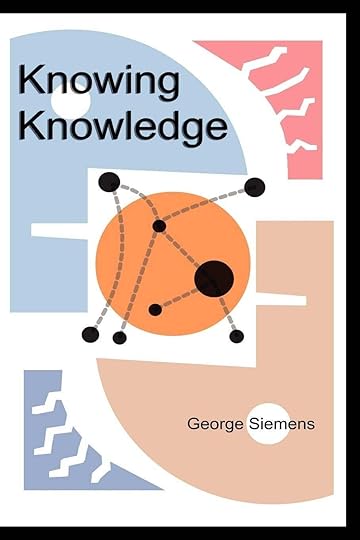
AmazonPDFImagesWiki
I have completed a humbly titled book Knowing Knowledge . I opted to go away from traditional publishers (to say knowledge is accelerating in pace and development, and then subject the book to an 18-month cycle seemed silly). The review process was based on transparency and end-user feedback before publication. The text was published via creative commons license (in physical and web format ).
Learning and knowledge are cornerstones for society and organizations. Knowing Knowledge is an exploration of the change impacting both learning and knowledge, and recommends changes required in order to align corporations and educational institutions with developing trends.
Table of Contents
Section 1: An Exploration of Theoretical Views of Knowing and LearningShifting 3What has caused knowledge to leave the safe, trusted spaces of generations past? 4What is the impact of knowledge set free? 5Many Faces Exploring Knowledge 13What are trusted sources of knowledge? 22Can a group be as effective as an expert? 22Learning 25In Relation to Knowing 49Why do we want knowledge? 50Is serendipity lost? 56Context Games 61What about power? 64Who are the new oppressed? 64Section 2: Changes and Implication — Moving toward ApplicationSomething is Amiss — Changed Environments of Knowledge 69Cycle of Change 69The rise of the individual 72Connectedness — the world has become whole 73Immediacy 74Breakdown and repackaging 74The conduit is king 75What is the impact? 76Socialization 77Blurring worlds 77Changed Characteristics and Flow of Knowledge 79Abundance 80Recombination 82Relation to certainty 82Development pace 83Representation 83Flow 84Spaces and structures of knowledge 86How can organizations adopt ecologies? 90Decentralization of knowledge 92Clear aims through decentralized means 95Affordance 98Emotions and Creativity 103Control and acceptance 105Quiet minds 106Scientist versus artist 107Implications — Structural/Spatial Impact 110Complexity corrodes clear paths 112Learners’ skills 113Designing 116Informal learning is too important to leave to chance 119Knowledge reflexivity 120Implementing 124Change forces change 127Domain Implementation Model 128Domain 1: Analysis and validation 130Domain 2: Network and ecology design 132Domain 3: Adaptive knowledge and learning cycle 134Domain 4: Systems and patterns review and evaluation 136Domain 5: Impacting factors 138Continuing the Conversation 143What is different tomorrow morning? 144From the Preface
We are able to describe, not define knowledge.
Most leaders today would settle for a view of knowledge that enables them to take action consistent with core changes — so their organizations do not suffer from outdated actions. Knowledge possesses two broad characteristics:
It describes or explains some part of the world (how atoms act, which companies to invest in for future growth, how diseases are spread),We can use it in some type of action (building particle accelerators, investing, preventing disease),All Knowledge is Information, but NOT all Information is Knowledge.
As goes knowledge, so go our organizations.
This book intends to serve 5 broad purposes:
To conceptualize learning and knowing as connection-based processes;To explore the nature of change in the context in which knowledge exists;To explore the change in the characteristics of knowledge itself;To present knowledge as a context-game — a dance that requires multiple realities, each selected to serve the intended needs of each task, challenge, or opportunity;To present a model for the spaces and structures which will serve the needs of our organizations (schools, universities, and corporations) for tomorrow.[image error]May 19, 2023
Knowledge Management Thought Leader 36: Charlene Li

Charlene Li specializes in disruption, digital transformation, leadership, customer experience and the future of work. She has written about social media, social business, and Enterprise Social Networks (ESNs).
She is the author or co-author of six books, including The Disruption Mindset, The Engaged Leader, Open Leadership, and Groundswell. She is a frequent blogger, speaker, and podcast guest.
EducationHarvard Business School — Master of Business AdministrationHarvard University — AB, Social StudiesExperienceChief Research Officer — PA Consulting, 2022 — PresentFounder, CEO, and Senior Fellow — Altimeter, a Prophet Company, 2008–2022Analyst and Research Director — Forrester Research, 1999–2008Internet Publisher — Community Newspaper Company, 1995–1999Project Manager — San Jose Mercury News, 1993–1995Consultant — Monitor Company, 1988–1991Profiles LinkedIn Bio Twitter Profiles in Knowledge BooksThe Disruption Mindset: Why Some Organizations Transform While Others Fail

The Engaged Leader: A Strategy for Your Digital Transformation

Open Leadership: How Social Technology Can Transform the Way You Lead
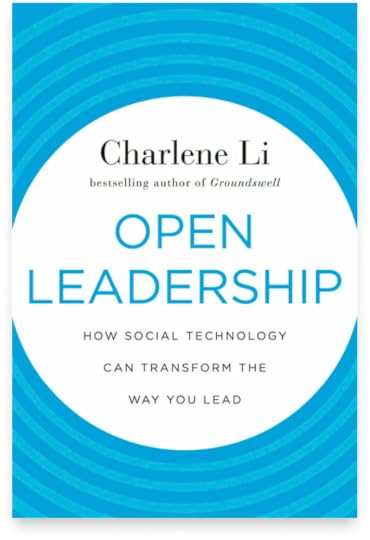
Groundswell, Expanded and Revised Edition: Winning in a World Transformed by Social Technologies with Josh Bernoff
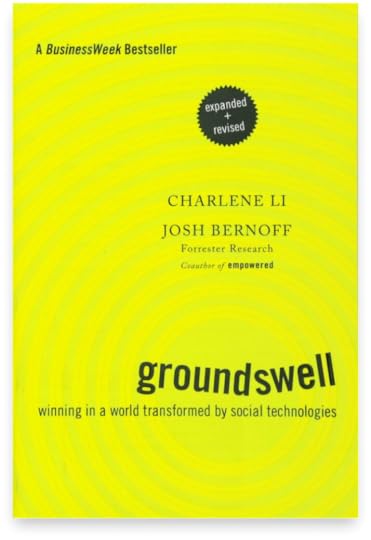 Videos
Wise Leaders Make Wise Decisions: How to Cultivate Wisdom at Work
Defining the Future of Work
YouTube Channel
YouTube Search
Vimeo
Presentations
SlideShare
Livestreams
Speeches
The Future Digital and Social Landscape
Podcasts
The New Rules of Disruption
Succeeding at Digital Transformation
What do the next five years of work look like?
Cultivating a Disruption Mindset
Disrupting your business
What leaders get most wrong about disruption
Digital Transformation Learning Path
The Community Roundtable Podcast
Fostering Product Innovation through Community & Customer Empathy
The Role of Communities in Navigating Disruption
Introduction to Disruption
Rule #1 — Lead Through Relationship
Rule #2 — Start with the Future in Mind
Rule #3 — Recognize The Power Shift
Rule #4 — Build Openness And Trust
Rule #5 — Embrace Healthy Conflict
Rule #6 — Scale Leadership With Agency
Rule #7 — Overcome the Resistance to Change
Rule #8 — Leverage Digital To Grow Relationships
Rule #9 — Replace Perfection with Excellence
Rule #10 — Embrace the Contradiction of Order and Change
Other Content
Website
Blog
LinkedIn Articles
LinkedIn Posts
Harvard Business Review
Articles
Navigating Change? You Might Need a Chief Transformation Officer
A Holistic, Four-Step Approach to Driving Sustainable Transformation
Can You Change a Large, Established Company’s Culture? Yes! Here’s How.
Five Actionable Ways to Create More Psychological Safety at Work
How I Consistently Create Thought Leadership
Impossible Deadlines Are Better Than Doable Deadlines. Here’s Why.
Silos: The Good, the Bad, the Dysfunctional — and the Fix
A simple gratitude practice will change your company culture
Can Operational Efficiency and Innovation Coexist? Yep! (And It’s Your Job as a Leader)
Does Culture Really Eat Strategy for Breakfast?!
Making the Business Case for Enterprise Social Networks
Videos
Wise Leaders Make Wise Decisions: How to Cultivate Wisdom at Work
Defining the Future of Work
YouTube Channel
YouTube Search
Vimeo
Presentations
SlideShare
Livestreams
Speeches
The Future Digital and Social Landscape
Podcasts
The New Rules of Disruption
Succeeding at Digital Transformation
What do the next five years of work look like?
Cultivating a Disruption Mindset
Disrupting your business
What leaders get most wrong about disruption
Digital Transformation Learning Path
The Community Roundtable Podcast
Fostering Product Innovation through Community & Customer Empathy
The Role of Communities in Navigating Disruption
Introduction to Disruption
Rule #1 — Lead Through Relationship
Rule #2 — Start with the Future in Mind
Rule #3 — Recognize The Power Shift
Rule #4 — Build Openness And Trust
Rule #5 — Embrace Healthy Conflict
Rule #6 — Scale Leadership With Agency
Rule #7 — Overcome the Resistance to Change
Rule #8 — Leverage Digital To Grow Relationships
Rule #9 — Replace Perfection with Excellence
Rule #10 — Embrace the Contradiction of Order and Change
Other Content
Website
Blog
LinkedIn Articles
LinkedIn Posts
Harvard Business Review
Articles
Navigating Change? You Might Need a Chief Transformation Officer
A Holistic, Four-Step Approach to Driving Sustainable Transformation
Can You Change a Large, Established Company’s Culture? Yes! Here’s How.
Five Actionable Ways to Create More Psychological Safety at Work
How I Consistently Create Thought Leadership
Impossible Deadlines Are Better Than Doable Deadlines. Here’s Why.
Silos: The Good, the Bad, the Dysfunctional — and the Fix
A simple gratitude practice will change your company culture
Can Operational Efficiency and Innovation Coexist? Yep! (And It’s Your Job as a Leader)
Does Culture Really Eat Strategy for Breakfast?!
Making the Business Case for Enterprise Social NetworksFour Ways Enterprise Social Networks Drive Value
Despite the promise and potential for ESNs, they have only received moderate traction. The problem is that most ESN deployments to date have been treated as technology deployments with a focus on adoption and usage. A different way to think about this is that ESNs represent a new way to communicate and form relationships — and because of that, can bridge gaps that exist in terms of information sharing and decision-making processes. To better understand these use cases, we found that they boil down to four different types of gaps in the organization — tough problems that can’t be addressed by the current technology, process, or culture.
Encourage sharing. Remember how revolutionary email was? It fundamentally changed the way we communicated by reducing the cost/effort and collapsing the time frame and scaling it to include multiple recipients. Social represents a fundamental change, simply because, at its essence, it encourages sharing. The simple presence of a status update box on a page encourages people to share their thoughts, activities, and expertise.Capture knowledge. Capturing the collective knowledge of an organization is a daunting task because it includes a wide range of facts, information, and skills gained through experience. Yet few people proactively sit down each day to document and capture their knowledge. ESNs provide an opportunity to do just that, by capturing glimpses of knowledge through profiles, activity streams, and interactions.Enable action. Having an ESN in place means that operations and processes can begin to change as well. This happens when the day-to-day process changes because the ESN enables new relationships and behaviors that address a gap that prevented actions from being taken.Empower employees. The last way ESNs drive value is that they empower and embolden people to speak up and join together, as well as gives them opportunities to contribute their skills and ideas.[image error]May 12, 2023
The Five Cs of KM: Collaborate, Part 4 — Working Out Loud
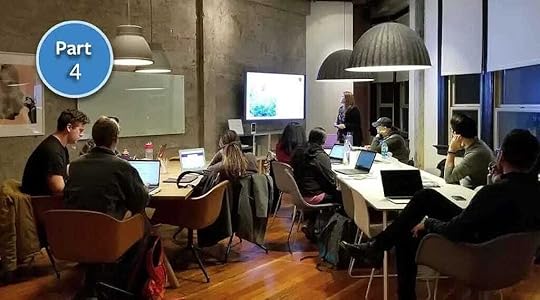
In Parts 2 and 3 of this series, I discussed collaborating in teams and communities. This fourth and final part covers Working Out Loud.
Working Out Loud (WOL) is an approach to collaboration in which employees form a virtual network and are encouraged to talk about their work and publish what they do. The goal is to inform others about current projects and to respond, learn, and apply the knowledge of others to their own work. WOL combines observable work (creating spaces where others can engage with your content) with narrating your work (posting in social software).
John Stepper has described 5 Elements of WOL:
Relationships: The path to opportunities and to knowledge is very often via other people. As you deepen relationships with people in your network, they’re more likely to help you or collaborate in some way.Generosity: Your contributions can include things as simple (and powerful) as recognition and appreciation. The reason generosity is a good way to build relationships is because we’re wired for reciprocal altruism. You can make contributions in a way that feels good and genuine knowing that, over the entirety of your network, there will naturally be a benefit to you too as others reciprocate.Visible work: When you make your work visible and frame it as a contribution, social platforms can amplify who you are, what you do, extend your reach, and greatly expand the set of contributions you can make and how you can offer them. The feedback on your visible work can also make you and your work better, thus tapping into your intrinsic need for learning.Purposeful discovery: Given the infinite amount of contributing and connecting you can do, you need to make it purposeful in order to be effective. As Working Out Loud becomes a habit, you can apply it towards any goal.Growth mindset: This is a more open, curious approach to work and life and more resilience in the face of setbacks. Adopting such a mindset means you’re more likely to try new things and to persist even when someone, for example, doesn’t respond to your contributions as you had hoped.Leading by example and persuading others helps create an open culture of truth, transparency, and trust; provides feedback loops; and spans organizational boundaries. Here are eight reasons for Working Out Loud rather than privately, through email messages, or in closed meetings:
Multiple people may need to know what is going on, to read updates, and to reply, and you may not know who all of them are. You can receive replies from all relevant people, and see all people who replied, unlike forwarded email.Providing transparency in thinking, decisions, and processes allows you to receive inputs and feedback from anyone willing to contribute. It enables vetting ideas in public by allowing others to weigh in, which helps achieve consensus. And leading by example encourages others to also work out loud.Working Out Loud enables and exploits serendipity. You can meet up with people wherever you are, who otherwise might not know you are going to be there. You can exchange and support ideas with other people attending the same events and allow those unable to attend to also benefit. And you can gain new colleagues by participating in recurring online chats.WOL allows others to benefit from seeing discussions, including receiving advice from unexpected sources based on relevant experience, receiving pointers to useful information, and helping others to learn and develop.You can keep an open record of discussions by maintaining a single thread with all replies in the same place, making it accessible to all who have an interest, and making it easy to refer back to the discussion and to provide a public link.Working Out Loud builds your personal brand. You can maintain a journal of your thinking for a permanent record, reuse your thoughts for blog posts and book chapters, and enhance your reputation as a thought leader.WOL avoids fragmentation into different email threads and different sets of people. There is no need to forward email messages, you can avoid having different people on different threads, and it prevents out-of-sync replies.If you work out loud, you progress from old ways of working to new and better ones. These include modeling the open way of working, demonstrating trust, and flattening out the hierarchy.People don’t always know what will be useful to them until they are made aware of it. When they see it in a feed to which they have opted in, in a newsletter to which they have subscribed, in a notification or alert they have elected to receive, or by monitoring the activity in a community, group, or team space, they can gain useful insights, learn, and otherwise benefit.
Many people are reluctant to ask for help but are thankful if someone shares something they can use. If I waited to receive questions before I shared my knowledge, I would miss out on helping a large number of people. If people seek information using a search engine, and it has not already been shared by posting, publishing, or previously answering queries, they will be unable to find it. And those who neither ask nor search will be out of luck.
A balance between supply and demand is desirable. But if you only wait for knowledge to be sought, and don’t have some people who share without being asked, people who never post (about 90% of community members) will be unable to benefit from a large supply of valuable knowledge.
Supply does not mean push. Push means forcing content on people who didn’t ask for it. Supply means making it available for those who subscribe, search, or are explicitly mentioned. Sharing without pushing can be done by posting in team spaces, group chats, and communities; by mentioning and tagging; and by reaching those who opt in and subscribe.
The power contained in Working Out Loud is that organizations tend to be insular — they have hierarchies, people communicate only in narrow groups, and email is still prevalent instead of enterprise social networks for more transparent communication. There is lip service given to the idea of using an enterprise social network, but then people revert to their old ways of communicating in small groups. For example, only sending email to people they know and trust because they do not want anybody else to know.
To collaborate effectively, organizations need to move from a need-to-know basis to need-to-share. This is a radical change that many organizations are not ready to embrace. But if people can work more transparently, that can help organizations be much more effective than traditional ways of working.
This concludes the fourth series on The Five Cs of KM. Please register for my webinar on the fourth C: Collaborate, where I will present on the topics covered in this series. And get ready for the final series of blog posts where I will discuss the fifth C: Create.
 The Five Cs of KM[image error]
The Five Cs of KM[image error]
May 5, 2023
The Five Cs of KM: Collaborate, Part 3 — Communities

In Part 2 of this series, I discussed collaborating in teams. This part covers collaborating in communities using threaded discussions, wikis, and events.
Threaded DiscussionsThreaded discussions are tools for carrying on discussions among subscribers on a specific subject, including online and email posts and replies, searchable archives, and discussions grouped by threads to show the complete history on each topic. Previously known as bulletin boards, listservs, newsgroups, message boards, discussion boards, online discussions, and forums. they provide benefits to their subscribers and to the organization. They enable subscribers to learn from other members; share new ideas, lessons learned, proven practices, and practical suggestions; reuse solutions through asking and answering questions, applying shared insights, and retrieving posted material; collaborate through conversations and interactions; and innovate through brainstorming, building on each other’s ideas, and keeping informed on emerging developments.
The organization benefits by having a reliable place where people with questions and problems can be directed to get answers and solutions, a searchable archive of the discussions, and a way for people to learn about their specialty and to develop in it. The broader the membership in a threaded discussion, the greater the benefit to the organization. This is due to having the widest possible range of perspectives, the greatest possible number of people to answer questions and solve problems, and greater leverage of all knowledge shared.
Providing a way for questions to be asked and answers to be supplied is a key function of threaded discussions. Subscribers post questions such as, “Has anyone done this before?”, “Does anyone know how to do this?”, and “Where can I find this?”, and other subscribers respond with answers, suggestions, and pointers to more information.
Another use of threaded discussions is sharing insights, techniques, and innovations with community members. Posting a tip on how a problem was solved, a user was helped, or a breakthrough was achieved allows many others to reuse that knowledge in other contexts.
When used in conjunction with community events, repository contributions, and published articles, threaded discussions allow communities to reflect on the events, provide feedback on the contributions, and debate ideas in the articles. This extends the useful life of events, publicizes submitted content, and stimulates the lively exchange of ideas.
Email is the killer application for communications, and threaded discussions are the killer application for communities. There is a connection between these two applications: threaded discussion tools need to allow for reading and posting entirely by email. When selecting or implementing such a tool, be sure that full email functionality is provided so that subscribers will not have to visit an online site in order to participate in discussions. Allowing users to choose between email or online interaction is valuable; both options should be provided.
Threaded discussions have advantages over ordinary email with distribution lists:
Users can typically choose to collaborate in one of three ways: online, entirely by email, or with mobile apps. This provides flexibility and accommodates personal preferences.Discussions are maintained in threads and can be more easily found and read.Threaded discussions can be searched from the specific platform or from enterprise search.When integrated with a KM recognition program, points can be automatically awarded for posts and replies to encourage participation.The user experience is greatly improved by actively managing communities to weed out dead ones, help community managers successfully build new ones, and avoid redundancy and topics that are too narrow or restrictive.Threaded discussions are the primary tool of online communities. This is where community members interact by sharing, asking, finding, answering, recognizing, informing, and suggesting.
To make these online threaded discussions work well as part of the community, there is basic functionality that should be provided. Posting and replying should be possible in a web browser, app, email, or mobile device. Users should not have to log into a system different from where they spend most of their time. For example, if they spend most of their time in email, make it so they can ask a question just by sending an email without having to leave email and visit a website.
Threaded discussions should have searchable archives. Once a discussion has taken place it should not be difficult to find it subsequently. Many discussions are still very helpful much later on. The fact that people took the time to help one another in the past can be useful again, so make it easy to find old discussions through search and tags.
Grouping online discussions into threads makes it very easy to see the entire history. If email is used instead for ongoing discussions, threading is either minimal or nonexistent. There is a long series of emails which makes it very hard to go back and reconstruct who asked what, who answered whom, and in what order. If you have ever had to grapple with a large group discussion conducted entirely via email, you know that it can easily get out of control. Some participants respond to an old email, leave someone off the distribution, or add a new addressee. This makes it difficult to sort out the order, determine, who was dropped, who was added, and what is missing. In contrast, in an online threaded discussion where everything is captured, there is no need to worry about any of that. The entire discussion is maintained in chronological order, threads are differentiated, and it is easy to see who answered whom, when they did it, and in what order.
WikisWikis are sites that allow users to easily add, remove, edit, and change most available content. They are effective for collaborative writing, self-service page creation, and shared maintenance of information. A wiki page can be edited by anyone, thus making it easy to collaborate on writing a document, creating a website, or collecting information on a topic. It has been most successfully used in Wikipedia, a free encyclopedia that has achieved dramatic levels of contribution and use.
Within communities, wikis have been used to create internal equivalents of Wikipedia for knowledge about the community and its activities. They are very well-suited for the production of documentation by teams of writers and editors, as the shared editing capability is ideal for this task. Wikis are also useful for collecting diverse inputs, links to other sites, and multiple points of view.
Wikis allow any community member to easily add, remove, and edit content. Instead of having to go through a website owner or web maintainer, a wiki enables everyone to do it themselves. They can create a page easily and maintain it on their own, with no need to contact a webpage editor.
Wikis include version control, so users can see all the different versions of a document or a page. They can see who made each change and when, and they can revert back to any previous version. If changes were made that should not persist, an earlier version can be easily restored.
Talk pages are another feature of wikis. Behind each wiki page there is often a tab to access a discussion about that page. For example, if there is a disagreement on what should be posted on the page, or if there is a clarification needed about a change, a discussion can take place right on the associated talk page.
Wikis generally have the ability to generate hyperlinks automatically. Normally when developing websites, links have to be manually inserted by explicitly copying and pasting a URL into a link field. But in a wiki the user can just type in the name of the item they wish to link to. If it already exists, it will automatically insert the hyperlink, and if not, it will insert a stub for creating one. If someone later creates that page, it will automatically be linked to from where it was first mentioned. In Wikipedia such stubs appear in red, meaning that a link is intended but there is currently no page for that link. If that page gets created, that link will change from red to blue, and when clicked on, it will turn to purple.
Here are ten use cases for wikis:
Collaborate on planning the agenda for a meeting.Compile the minutes from a meeting.Provide a list of resources that can be updated, added to, and corrected by anyone.Capture and maintain a body of knowledge that will evolve through iterative definitions from multiple contributors, compiling diverse inputs to create a thorough content collection.Collect, enhance, and maintain reference information for a community.Create an outline that will be fleshed out over time by a variety of subject matter experts.Enable employees to create and collaboratively edit their own content pages.Encourage users to collaboratively edit community support pages.Brainstorm to come up with new ideas.Achieve consensus on a topic, e.g., drafting and developing a policy or procedure.EventsCommunity events can extend the value of communities beyond online discussions and wikis, which are limited to text and images. These events include meetings, peer assists, and knowledge cafés.
MeetingsRegular in-person meetings, video conferences, web conferences, or conference calls are good for building rapport and trust within communities. Face-to-face meetings and video conferences allow members to see each other and deepen relationships. Web conferences and conference calls enable voices to be heard. Threaded discussions can be used to publicize meetings, team spaces can hold calendars and meeting agendas, and wikis can store slides, recordings, and group chat transcripts.
The community that I lead, the SIKM leaders Community, has monthly calls with speakers scheduled well in advance. Community members are invited to attend to listen to the speaker, ask questions, and interact with one another.
 SIKM Leaders CommunityPeer Assists
SIKM Leaders CommunityPeer AssistsA peer assist is a process where a team of people working on a project or activity call a meeting or workshop to seek knowledge and insights from people in other teams. Developed at BP, it was used to learn from the experiences of others before embarking on an activity or project. A peer assist brings together a group of peers to elicit feedback on a problem, project, or activity, and to draw lessons from the participants’ knowledge and experience.
It was originally designed as a one to two-day facilitated meeting involving two groups of professionals: a team trying to deal with the critical business issue, and a team of subject matter or domain experts whose knowledge and experience can be tapped. The ability of the peer assist to tap into new expertise makes it a valuable tool that yields immediate insights and results.
In communities, peer assists can be conducted as shorter, virtual events. A community member facing a challenge can schedule a peer assist to seek help from the community. The member presents the challenge, and the community responds with advice and suggestions. The event can be recorded so others who were unable to attend can benefit.
Knowledge CaféA knowledge café is a conversational process that brings a group of people together to share experiences, learn from each other, build relationships, and make better sense of a rapidly changing, complex, less-predictable world. The goal is to improve decision making, innovation, and the ways in which people work together. It is an intentional way to create a living network of conversation around questions that matter. It is a creative process for leading collaborative dialogue, sharing knowledge, and creating possibilities for action in groups of all sizes.
In a knowledge café, a subject is chosen for discussion. There is an initial brief presentation followed by breaking up into groups. If held in person, these are at different tables, and if virtual, these are breakout rooms. The participants take turns talking about the topic and then rotate to a different table or breakout room. They keep rotating several times, and a result, gain many different perspectives. This can be a very useful way to start conversations and get people who might otherwise just sit back and listen to be active participants in a discussion.
Principles, Keys to Success, and Actions10 PrinciplesHere are ten principles for successful communities:
Communities should be independent of organization structure. They are based on what members want to interact on.Communities are different from teams. They are based on topics, not on assignments.Communities are not sites, team spaces, blogs or wikis. They are people who choose to interact.Community leadership and membership should be voluntary. You can suggest that people join but should not force them to.Communities should span boundaries. They should cross functions, organizations, and geographic locations.Minimize redundancy in communities. Before creating a new one, check if an existing community already addresses the topic.Communities need a critical mass of members. Take steps to build membership.Communities should start with as broad a scope as is reasonable. Separate communities can be spun off if warranted.Communities need to be actively nurtured. Community leaders need to create, build, and sustain communities.Communities can be created, led, and supported using TARGET : T ypes (TRAIL — Topic, Role, Audience, Industry, Location), A ctivities (SPACE — Subscribe, Post, Attend, Contribute, Engage), R equirements (SMILE — Subject, Members, Interaction, Leaders, Enthusiasm), G oals (PATCH — Participation, Anecdotes, Tools, Coverage, Health), E xpectations (SHAPE — Schedule, Host, Answer, Post, Expand), T ools (SCENT — Site, Calendar, Events, News, Threads).5 Keys to SuccessHere are five keys to success for a community of practice:
A compelling topic: The members and potential members must identify with the topic, be passionate about it, and it must be relevant to their work.A critical mass of members: You usually need at least 100 members, with 200 being a better target.A committed leader: A capable community manager chooses to spend time leading the community.Regular events: Conference calls, webinars, or in-person meetings are scheduled and held regularly.Active online discussions: Regular posts are made, multiple replies are received, and no questions are left unanswered in the threaded discussions.10 ActionsHere are ten actions community managers should take:
Carefully choose the community’s topic.Publicize the community widely.Take steps to increase membership, both initially and on an ongoing basis.Post and reply in the threaded discussions to prime the pump and set the example.Publish and distribute a monthly community newsletter.Schedule and host community events.Provide useful content.Tell community members how they should participate.Set goals and measure progress for the community.Solicit, find, and publicize success stories about the community.In Part 4 of this series, I will discuss working out loud.
 The Five Cs of KM[image error]
The Five Cs of KM[image error]
April 28, 2023
The Five Cs of KM: Collaborate, Part 2 — Teams
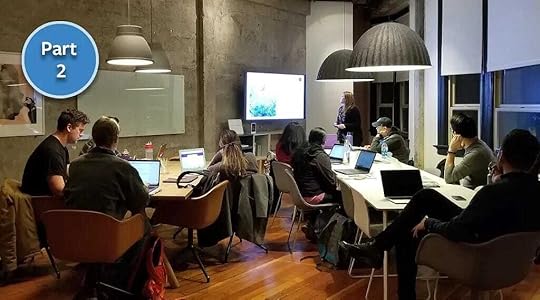
In Part 1 of this series, I discussed use cases for collaboration. In this part, I discuss collaborating in teams.
Collaboration as part of a team is important for any organization with a project-based approach. Before there were collaboration tools, teams had to rely on passing pieces of paper back and forth or being physically together in the same place. But with modern tools there are ways of making collaboration more efficient. These include team spaces, group chat, and web conferencing.
Team SpacesTeam spaces are collaborative workspaces designed to allow teams to share documents, libraries, and schedules; conduct meetings, surveys, and polls; and store meeting minutes, discussions, reports, and plans. A team space is a site that enables team members to post and retrieve files, share information, and participate in group activities. If teams lack such a tool, they need to send more email to one another, they struggle to locate required documents, and could lose access to critical information when one of the team members is unavailable or leaves the organization.
Using file shares, shared drives, and other ad hoc storage mechanisms is an unreliable way to collaborate. Providing a standard, readily accessible, predictable, and backed-up environment enables effective and enduring collaboration to occur. Team spaces provide access to all project information from any place at any time without relying on the presence of any one person.
Following are guidelines for offering, creating, and using team spaces.
Make it fast and easy to create a team space using a self-service intranet site. Provide standard templates for work teams, project teams, and communities to use when creating new team spaces. These templates can provide a consistent look and feel, useful links, and required documents.Establish and communicate rules for allowable file types, backup frequency, and storage quotas. Regularly communicate to users about inactive team spaces, storage usage, and maintenance schedules.Define the team members and provide access for each of them. Define at least two administrators for each team space.Provide a team roster page where members can post their photos, add links to personal sites, and describe their roles. Populate it with available data and encourage team members to expand and update their information.Establish rules that all files should be shared by posting to the team space, not by sending as email attachments. Remind new users about how to do this.Set up recurring meetings in the team space so that for each meeting, there is a webpage with the agenda, attendees, action items, and shared documents. Allow users to add their names to the attendee list.Allow users to subscribe to alerts for notification when new documents are posted to the team space or when other changes are made. Explain how to do this and encourage all team members to do so.Use polls to conduct surveys, take votes, and made decisions. Publish the results in the team space.Discourage team collaboration from taking place outside the team space. For example, project team members should not maintain any files on other sites.Create a process for deciding which files are kept in the team space, posted to reusable document repositories, archived, and deleted. Ensure that the process is followed.Group ChatYou can reduce the need for face-to-face meetings and disruptive phone calls by offering persistent group chat for project teams. Team members can interact with each other through chat and avoid the need to visit, call, or send email. When they have a quick question or quick update, they can post it in the group chat, and everybody gets it right away. They don’t have to schedule a conference call or meet in person.
Group chat enables a more natural flow of information and allows for sharing critical information instantly rather than waiting for meetings or waiting for emails to be read. It should not be used for community threaded discussions, which are better served by tools designed for that purpose.
Web ConferencesVirtual teams have become widespread. In the past, team members were often located in the same location and could meet in person whenever they wanted. Now they are often widely distributed across geographies, might never have met one another in person, and communicate primarily through email, instant messaging, and telephone calls.
Most people are now accustomed to using tools such as Zoom, Google Meet, and Microsoft Teams due to the COVID-19 pandemic. This familiarity make it easier to use these routinely as part of ongoing team collaboration. Web conferencing tools allow participants to view common presentations, share applications, write on virtual white boards, conduct polls, engage in group chats, and see one another on video.
Virtual meeting rooms are online, real-time tools designed to allow teams to share presentations, applications, and white boards during meetings. Videoconferencing is technology that allows two or more locations to communicate by simultaneous two-way video and audio transmission. Telepresence allows a person to feel as if they were present, and to give the appearance of being present, at a place other than their true location. Advances in video conferencing technology allow more closely approximating in-person meetings. Participants actually feel as though they are in the same room despite being in different locations.
All these tools can reduce or eliminate the need for physical travel in order to convene a group. But it can be frustrating not seeing everyone’s body language, facial expressions, and physical responses. If the newer technology can better enable this, it will greatly enhance collaboration.
Collaboration ProcessA standard collaboration process ensures a predictable, reliable, backed-up, and supported environment, which is preferable to ad hoc methods such as email, shared drives, personal hard drives, or unsupported tools. The process should allow a team to continue collaborating without losing information even if one or more of the members departs, a PC is lost or stolen, or a hard drive fails.
Without a standard, collaboration will happen in a variety of sub-optimal ways, or not at all. Thus, it is desirable to define a policy requiring all teams to follow the collaboration process. The policy should be supported by a standard tool for collaboration, with an easy to use self-service creation process. Until collaboration becomes ingrained, make it one of the three KM goals for all employees to whom it is relevant. For example, “For every project, a team space using the standard collaboration tool should be created for project team collaboration.” Then report each month on progress toward achieving the goal.
The combination of a quick self-service creation process for team spaces, the ease of use of the chosen collaboration tool, and an employee goal should lead to rapid and widespread adoption. As a result, you should be able to declare success and replace the collaboration goal with a different goal for the subsequent year.
A collaboration process should include a policy, procedure, standard tool, standard templates for different types of teams, training, and support. It can be supplemented with a capture process that allows reusable content to be selected from team spaces and submitted to appropriate repositories for later reuse.
Providing a standard, supported way for teams to collaborate is a basic enabler of knowledge management. It allows knowledge to flow between people, creates an environment where documents and ideas are shared, and provides supporting tools such as polls that make it easy to find out what team members are thinking.
ExampleAt HP, we wanted to establish that collaboration was expected to occur, and in a standard way. Before there was such a standard, people were collaborating informally, sending email to one other, or storing documents on personal hard drives. The problem was that if someone left the project team, someone else who wanted to find out what had been shared might not be able to get it. Without a standard way to collaborate, we would have been unable to achieve our desired form of collaboration.
Just requiring team collaboration is not enough. You have to make it easy for people to create a collaboration space. At HP, we used Microsoft SharePoint team sites. This allowed us to emphasize self-service — anyone could create and begin using their own team site in just a few minutes. We provided a template and allowed users to populate it with standard information and links that a project typically needed. This really helped things take off. One of HP’s three original KM goals was that every project should establish a project space. But we no longer needed that as an explicit goal because everybody had started doing it routinely.
It is important to identify the business need that collaboration addresses. At HP, it was the need for project teams to work together, to communicate effectively, and to have common access to documents. We created a standard environment that did not require people to learn multiple tools or prevent them from reusing materials across projects. The self-service element was important — people didn’t have to wait for the IT department to create sites for them.
The collaboration process spanned four stages in the project lifecycle:
In the initial phase, someone began pursuing an opportunity. They started up a collaborative team space for the team going after the deal.They began including people from the sales force, people from services, or anyone within the company working on that deal who needed to collaborate.As the project moved along, new project team members might be added, and the project manager might get assigned to work on another deal. Teams needed a way for things to be handed off from the sales part of the opportunity to the delivery part of it. The team space offered a good way for handoffs to happen, to prevent information from being lost, and to ensure key materials (e.g., proposals and project plans) were widely reusable.Finally, these documents could be shared from the team space into the project document library, where others could access and reuse them. A standard workflow process moved documents from the team space into the project document library.In Part 3 of this series, I will discuss collaborating in communities.
 The Five Cs of KM[image error]
The Five Cs of KM[image error]
April 22, 2023
The Five Cs of KM: Collaborate, Part 1 — Use Cases
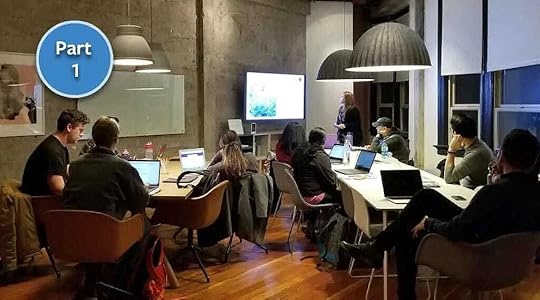
This begins the fourth series on knowledge management in special libraries and information centers, structured around Five Cs: Capture, Curate, Connect, Collaborate, and Create. This four-part series is about the fourth C: Collaborate.
Collaboration is interacting with peers and colleagues to exchange ideas, share experiences, work together on projects, and solve problems. Work teams, project teams, and communities need consistent ways to share their knowledge, coordinate their activities, and communicate with one another. Providing standard collaboration processes and tools ensures users will not have to learn new ones frequently.
Use CasesThe words collaborate, collaboration, and collaborative are often used without much detail about what is meant. Here are use cases for collaboration to answer the question, “When you say collaborate, what exactly do you want to do?” along with examples for each one.
COLLABORATION: Communicate, Obtain, Locate, Learn, Assist, Build, Offer, Resolve, Ask, Transfer, Innovate, Onboard, Network
Communicate: Inform the organization about your activities, plans, and progress. Interact with colleagues. Solicit input, feedback, and advice. Relax, refresh, relieve tension, and laugh.
“I will be the project manager for the conversion effort.”“Here is the statement of work for the project plan.”“I’m looking for feedback on the plan.”Schedule a group dinner at an upcoming conference.Obtain: Gain assistance from others. Find out what others are doing. Retrieve information. Receive answers to questions.
“I can use some help in setting up the meeting room for our monthly meeting.”“How are all of you dealing with the upcoming software migration?”Reuse a proposal from the document library.“Here is a link to a presentation you can use.”Locate: Find subject matter experts. Find documents, references, sites, official methods, lessons learned, and proven practices. Find needed resources.
“I’m looking for a network security specialist to join a new project.”“Does anyone have a tool I can use for social network analysis?”Look in the community threaded discussion archives to find a relevant solution.Learn: Master a subject. Deepen expertise in a specialty. Keep current on the latest news in a topic.
Participate in a training event.Attend a community call featuring a presentation on a topic of interest.Read a community newsletter for the most recent updates.Assist: Respond to a request. Respond to a request for information, proposal, or support. Submit a proposal. Deliver a product, project, or service. Provide advice, guidance, and thought leadership.
“The attached document provides the answer to your question.”Offer to get on a call to help solve a problem.Develop a grant proposal based on content from a knowledge repository.Deliver a service as part of a team.“Based on my experience, I suggest that you follow the steps outlined in the document linked to below.”Build: Develop and deliver thought leadership in the form of advice, writing, presentations, audio recordings, or videos. Write a document or create a presentation. Record a podcast or a video. Create and deliver a product or service.
Publish a white paper on a new methodology you helped develop.“I am sharing the tweet transcript of my notes from last week’s conference.”“Here is the recording of today’s community call.”Collaborate to create a new service.Offer: Answer questions. Provide points of view, proven practices, lessons learned, examples, or official methods. Get assigned to a project. Lead an effort. Praise, recognize, and thank colleagues.
“I experienced that same bug and discovered this workaround.”“My view is slightly different, based on my time working in South America.”“I am a user experience designer available to join a project immediately.”Serve as project manager for an initiative.“I would like to thank everyone who contributed to the discussion. Your insights were most valuable in helping me decide what to do next.”Resolve: Identify issues. Solve problems. Fix something that is broken.
Work with others to create a list of important issues.Provide a peer assist to solve a problem faced by a community member.“We fixed the bug that prevented search from returning recent results.”Ask: Pose questions. Request advice. Submit a query or request.
“What is the best way to record a podcast?”“How have you been able to convince senior leaders to provide funding?”“I need help in migrating to a new platform.”Transfer: Transmit knowledge. Share links, insights, lessons learned, tips, tricks, and techniques. Contribute reusable content. Submit documents.
Lead a training session.“I am posting a link to an article I recently published.”“I will present the new methodology on this month’s community call.”“The project artifacts are now available in the document repository.”Innovate: Develop new and better ways of doing things. Solicit ideas. Manage the innovation process. Improve existing products, services, processes, and tools. Invent new products, services, processes, and tools.
Work with others to improve the service desk call handling process.“What features should be part of the new platform?”Conduct an innovation challenge using threaded discussions, community calls, and a wiki.“Please review the list of suggestions and vote on the top three.”Participate in a task force chartered to develop a new service to replace an old one.Onboard: Induct new hires or team members into the organization. Get oriented as a new hire or team member. Orient new users.
Offer help to people who have just joined the organization.Attend an event where experiences are shared with new team members.“Please sign up to help present at next month’s new user orientation session.”Network: Connect to others with similar interests. Work together as part of a team. Connect multiple organizations to deliver services as one.
Invite a community member whose posts have been helpful to meet up for a chat.“I am looking for volunteers to work on the annual meeting.”Pull together members from different parts of the organization to deliver services.Knowledge management programs typically include multiple modes of collaboration. Three of these are working in teams, participating in communities, and working out loud. In Part 2 of this series, I will discuss collaborating in teams.
 The Five Cs of KM[image error]
The Five Cs of KM[image error]
April 20, 2023
Nick Bontis: Profiles in Knowledge
 Nick Bontis: Profiles in Knowledge
Nick Bontis: Profiles in KnowledgeThis is the 90th article in the Profiles in Knowledge series featuring thought leaders in knowledge management. Nick Bontis is Chair of Strategic Management at the DeGroote School of Business, McMaster University in Hamilton, Ontario, Canada. He is also the Director of the Institute for Intellectual Capital Research a management consulting firm and research think-tank that specializes in conducting human capital diagnostic assessments for corporate and government clients.
His research focuses business performance, intellectual capital, knowledge management, organizational learning, collaboration, human capital measurement, and digital transformation. Nick has expertise in leadership & productivity, management of change, information overload, knowledge sharing, innovation & creativity, team collaboration, and talent retention.
Nick is a former semi-professional soccer player and national silver medalist in the running long jump. In 2010, Nick was recognized as an Olympic Torch Bearer for the Winter Games as a testament to his dedication to volunteerism and coaching. In 2012, he was elected to serve on the Board of Directors for the Canadian Soccer Association. He recently resigned as president of Canada Soccer. In 2015, he was recognized for his significant contribution to sport by being selected as a PanAm torch bearer and appointed Co-Chair of Football.
I heard Nick speak at the APQC Knowledge Management Conference in St. Louis in 2005. I was impressed by his intellectual capital ROI causal map.
Background EducationPh.D., Strategic Management, Ivey School of Business, University of Western Ontario, 1999B.A., (HBA), Honors Business Administration, Ivey School of Business, University of Western OntarioExperienceDeGroote School of Business — McMaster University: Chair, Strategic Management, 2013 — PresentMcMaster University: Associate Professor of Strategy, 1998 — Present: Teaching courses in strategy and knowledge managementInstitute for Intellectual Capital Research: Director, 1994 — PresentCIBC: Project Analyst, 1992–1994ProfilesDeGroote School of Business at McMaster UniversityPromotional FlyerBioCanadian Soccer ProfileInformation Bombardment BioTwitterFacebookLinkedInInstagramWikipediaResearch.comContentThe intellectual core and impact of the knowledge management academic disciplineIntellectual Capital Five Ways to Keep it From Walking Out the DoorCKO wanted — evangelical skills necessary: a review of the Chief Knowledge Officer position(1999) Managing organizational knowledge by diagnosing intellectual capital: A critical review of the field and introduction to a three-stage model. Journal of Management Studies, 36(6), 855–882.(2001) Assessing knowledge assets: A review of the literature and a proposed framework for measuring knowledge stocks and flows. Journal of Intellectual Capital, 2(1), 11–34.Emerald InsightResearchGateAcademia.eduSemantic Scholardblp Computer Science BibliographyLinkedIn PostsInformation Bombardment BlogGoogle ScholarTranslating knowledge management into performance: the role of performance measurement systemsMining the nation’s intellectual capital: knowledge management in governmentSelling expertise to the highest bidderUnderstanding the practical relevance of academic research in knowledge management: a lay epistemic theory approachResearchBontis, N., Ciambotti, M., Palazza, F. and Sgro, F. (2018). “Intellectual capital and financial performance in social cooperative enterprises”, Journal of Intellectual Capital, Vol. 19, №4, final acceptance September 26 2017.Dzenopoljac, V., Alasadi, R., Zaim, H. and Bontis, N. “Impact of knowledge management processes on business performance: Evidence from Kuwait”, Knowledge and Process Management, final acceptance, December 19, 2017.Aureli, S., Giampaoli, D., Ciambotti, M. and Bontis, N. “Key factors that improve knowledge-intensive business processes which lead to competitive advantage”, Business Process Management Journal, final acceptance, November 9, 2017.Serenko, A. and Bontis, N. (2017). “Global ranking of knowledge management and intellectual capital academic journals: 2017 update”, Journal of Knowledge Management, Vol. 21, №3, pp. 675–692.Giampaoli, D., Ciambotti, M., and Bontis, N. (2017). “Knowledge management, problem solving and performance in top Italian firms, Journal of Knowledge Management, Vol. 21, №2, pp. 355–375.Ramadan, B.M., Dahiyat, S.E., Bontis, N. and Al-dalahmeh, M.A. (2017). “Intellectual capital, knowledge management and social capital within the ICT sector in Jordan”, Journal of Intellectual Capital, Vol. 18, №2, pp. 437–462.Serenko, A., and Bontis, N. (2016). “Understanding counterproductive knowledge behavior: Antecedents and consequences of intra-organizational knowledge hiding”, Journal of Knowledge Management, Vol. 20, №6, pp. 1199–1224.Serenko, A. and Bontis, N. (2016). “Negotiate, reciprocate, or cooperate? The impact of exchange modes on inter-employee knowledge sharing”, Journal of Knowledge Management, Vol. 20, №4, pp. 687–712.Ngah, R., Tai, T. and Bontis, N. (2016). “Knowledge management capabilities, learning organization and organizational performance in Roads and Transport Authority of Dubai: The mediating role of Learning Organization”, Knowledge and Process Management, Vol. 23, №3, pp. 184–193.Serenko, A., Bontis, N., and Hull, E. (2016). “An application of the knowledge management maturity model: The case of credit unions”, Knowledge Management Research and Practice”, Vol. 14, №3, pp. 338–352.Moshonsky, M., Serenko, A., and Bontis, N. (2014). “Examining the transfer of academic knowledge to business practitioners: Doctoral program graduates as intermediaries”, International Journal of Knowledge Management, Vol. 10, №3, pp. 70–95.Crane, L., and Bontis, N. (2014). “Trouble with tacit: developing a new perspective and approach”, Journal of Knowledge Management, Vol. 18, №6, pp. 1127–1140.Curado, C., Guedes, M. and Bontis, N. (2014). “The financial crisis of banks (before, during and after): An intellectual capital perspective”, Knowledge and Process Management, Vol. 21, №2, pp. 103–111.Chew, A-L., Sharma, R. and Bontis, N. (2014). “Intellectual wealth of nations revisited: Operationalising the value cycle of innovation”, Knowledge and Process Management, Vol. 21, №1, pp. 1–12.Serenko, A. and Bontis, N. (2013). “Investigating the current state and impact of the intellectual capital academic discipline”, Journal of Intellectual Capital, 14, 4, 476–500.Serenko, A., and Bontis, N. (2013). “Global ranking of knowledge management and intellectual capital academic journals: 2013 update”, Journal of Knowledge Management, 17, 2, 307–326.Serenko, A. and Bontis, N. (2013). “The intellectual core and impact of the knowledge management academic discipline”, Journal of Knowledge Management, 17, 1, 137–155.Booker, L., Bontis, N. and Serenko, A. (2012). “Evidence-based management and academic research relevance”, Knowledge and Process Management, 19, 3, 121–130.Serenko, A., Bontis, N. and M. Moshonsky. (2012). “Books as a knowledge translation mechanism: Citations analysis and author survey”, Journal of Knowledge Management, 16, 3, 495–511.Serenko, A., Cox, R., Bontis, N. and L. Booker. (2011). “The superstar phenomenon in the knowledge management and intellectual capital academic discipline”, Journal of Informetrics, 5, 3, 333–345.Bontis, N., Richards, D. and A. Serenko. (2011). “Improving service delivery: Investigating the role of information sharing, job characteristics, and employee satisfaction”, The Learning Organization, 18, 3, 239–250.Curado, C. and N. Bontis. (2011). “Parallels in knowledge cycles”, Computers in Human Behavior, 27, 4, 1438–1444.Serenko, A., Bontis, N. and E. Hull. (2011). “Practical relevance of knowledge management and intellectual capital scholarly research: Books as knowledge translation agents”, Knowledge Process Management, 18, 1, 1–9.Trevinyo-Rodriguez, R.N. and N. Bontis. (2010). “Family ties and emotions: A missing piece in the knowledge transfer puzzle?”, Journal of Small Business and Enterprise Development, 17, 3, 418–436.Serenko, A., Bontis, N., Booker, L., Sadeddin, K., and Hardie, T. (2010) “A scientometric analysis of knowledge management and intellectual capital academic literature (1994–2008)”, Journal of Knowledge Management, 14, 1, 3–23.Rezazadeh Mehrizi, M.H. and N. Bontis. (2009). “A cluster analysis of the KM field”, Management Decision, 47, 5, 792–805.Bontis, N. and A. Serenko. (2009). “A follow-up ranking of academic journals”, Journal of Knowledge Management, 13, 1, 16–26.Schotter, A. and N. Bontis. (2009). “Intra-organizational knowledge exchange: An examination of reverse capability transfer in multinational corporations”, Journal of Intellectual Capital, 10, 1, 149–164.Bontis, N. and A. Serenko. (2009). “Longitudinal knowledge strategising in a long-term healthcare organisation”, International Journal of Technology Management, 47, 1/2/3, 276–297.Serenko, A. and N. Bontis. (2009). “Global ranking of knowledge management and intellectual capital academic journals”, Journal of Knowledge Management, 13, 1, 4–15.Booker, L., Bontis, N. and A. Serenko. (2008). “The relevance of knowledge management and intellectual capital research”, Knowledge and Process Management, 15, 4, 235–246.Bontis, N., Hardie, T. and A. Serenko. (2008). “Self-efficacy and KM course weighting selection: Can students optimize their grades?”, International Journal of Teaching and Case Studies, 1, 3, 189–199.Serenko, A., Bontis, N. and T. Hardie. (2007). “Organizational size and knowledge flow: A proposed theoretical link”, Journal of Intellectual Capital, 8, 4, 610–627.Kristandl, G. and N. Bontis. (2007). “Defining intangible assets and intellectual capital”, Management Decision, 45, 9, 1510–1524.Curado, C. and N. Bontis. (2007). “Managing intellectual capital: The MIC Matrix”, International Journal of Knowledge and Learning, 3, 2/3, 316–328.Andreou, A. and N. Bontis. (2007). “A model for resource allocation using operational knowledge assets”, The Learning Organization: An International Journal, 14, 4, 345–374.Bontis, N. and A. Serenko. (2007). “The moderating role of human capital management practices on employee capabilities”, Journal of Knowledge Management, 11, 3, 31–51.Bontis, N., Serenko, A. and E. Biktimirov. (2006). “MBA Knowledge Management Course: Is there an impact after graduation?”, International Journal of Knowledge and Learning, 2, 3/4, 216–237.Curado, C. and N. Bontis. (2006). “The knowledge based-view of the firm and its theoretical precursor”, International Journal of Learning and Intellectual Capital, 3, 4, 367–381.Serenko, A. and Bontis, Nick. (2004). “Meta-review of knowledge management and intellectual capital literature: Citation impact and research productivity rankings”, Knowledge and Process Management, 11, 3, 185–198.Chauhan, N. and Nick Bontis. (2004). “Organizational Learning Via Groupware: A path to discovery or disaster?”, International Journal of Technology Management, 27, 6/7, 591–610.Bontis, Nick, Fearon, M. and M. Hishon. (2003). “The eFlow Audit: An evaluation of e-mail flow within and outside a high-tech firm”, Journal of Knowledge Management, 7, 1, 6–19.Bontis, Nick and Jac Fitz-enz. (2002). “Intellectual Capital ROI: A causal map of human capital antecedents and consequents”, Journal of Intellectual Capital, 3, 3, 223–247.McKnight, Brent and Nick Bontis. (2002). “E-Improvisation: Collaborative Groupware Technology Expands the Reach and Effectiveness of Organizational Improvisation”, Journal of Knowledge and Process Management, 9, 4, 219–227.Stovel, Meaghan and Nick Bontis. (2002). “Voluntary Turnover: Knowledge management friend or foe?”, Journal of Intellectual Capital, 3, 3, 303–322.Bontis, Nick. (2002). “The rising star of the Chief Knowledge Officer”, Ivey Business Journal, March/April, 20–25.Bontis, Nick. (2001). “Assessing Knowledge Assets: A review of the models used to measure intellectual capital”, International Journal of Management Reviews, 3, 1, 41–60.Bontis, Nick and D. Nikitopoulos. (2001). “Thought leadership on intellectual capital”, Journal of Intellectual Capital, 2, 3, 183–191.Bontis, Nick. (2001). “CKO Wanted — Evangelical Skills Necessary: A review of the Chief Knowledge Officer position”, Knowledge and Process Management, 8, 1, 29–38.Bontis, Nick and John Girardi. (2000). “Teaching Knowledge Management and Intellectual Capital Lessons: An empirical examination of the TANGO simulation”, International Journal of Technology Management, 20, 5/6/7/8, 545–555.Bontis, Nick, Dragonetti, N., Jacobsen, K. and G. Roos. (1999) The Knowledge Toolbox: A review of the tools available to measure and manage intangible resources, European Management Journal, 17, 4, 391–402.Bontis, Nick. (1999). “Managing Organizational Knowledge by Diagnosing Intellectual Capital: Framing and advancing the state of the field”, International Journal of Technology Management,18, 5/6/7/8, 433–462.Bontis, Nick. (1998). “Intellectual Capital: An exploratory study that develops measures and models”, Management Decision, 36, 2, 63–76.Articles by OthersJack Vinson: Based on research by Nick Bontis (the graph was interesting), there is no connection between education (formal or on-the-job) and “knowledge generation,” and this is consistent across a number of industries.Dave Webb: According to intellectual capital expert Nick Bontis of McMaster University, there are two major barriers in North America to a successful knowledge management environment. One is the input bottleneck — though we can speak at 150 words a minute, most of us can’t tickle a keyboard faster than 50 words per minute. This causes us to be selective about what we share, though frequent readers of this space might disagree. The second is cultural — unlike, say, Japanese companies, North American firms tend to disseminate business information from the top down. Japanese workers are more accustomed to a collaborative environment — horizontal sharing of information. North American workers lean more toward the knowledge-is-power ethic — hoarded knowledge is leverage.Jay Liebowitz: Strong managerial leadership is positively correlated to the retention of key people, based on Nick Bontis and Alexander Serenko’s work in Canada.Stephen Abram: One of the challenges for any conference is keeping attendees engaged through the last afternoon. Nick Bontis, the wrap-up keynote on Day 3 of KMWorld 2000, was a compelling reason.KMWorld Magazine: “IntraKnexa was developed from the ground up with the help of the best KM practitioners and researchers from around the world,” says Knexa CKO Nick Bontis. “We have integrated IT and HR into the KM solution. I am not aware of any other KM tool that actually provides incentives for users to share knowledge.”As Quoted by MeTom Stewart in his book The Wealth of Knowledge demonstrates how the building and leveraging of organizational knowledge assets can be at the heart of value generation. In chapter 14 (pages 311–313), he refers to the excellent work of Nick Bontis on human capital formation.Favorite knowledge management and intellectual capital booksWorld Congress on Intellectual Capital Readings “My collection of best research from the World Congress”The Strategic Management of Intellectual Capital and Organizational Knowledge by Chun Wei Choo “A fantastic textbook for KM and IC researchers and practitioners”The Knowledge-Creating Company: How Japanese Companies Create the Dynamics of Innovation by Ikujiro Nonaka and Hirotaka Takeuchi “A must read for KM enthusiasts describing the robust SECI model”Enabling Knowledge Creation: How to Unlock the Mystery of Tacit Knowledge and Release the Power of Innovation by Georg Von Krogh “Georg is a leading researcher in the field”Intellectual Capital: The New Wealth of Organizations by Thomas A. Stewart “A best-selling FORTUNE magazine editor who is a master storyteller”Intellectual Capital: Navigating in the New Business Landscape by Johan Roos, Goran Roos, Nicola Carlo Dragonetti, and Leif Edvinsson “A great read from my friends at ICS in London”The Knowing-Doing Gap: How Smart Companies Turn Knowledge into Action by Jeffrey Pfeffer and Robert Sutton “Bob is a bright guy and his book is good reading”Working Knowledge by Thomas H. Davenport and Laurence Prusak “Davenport at Accenture and Prusak at IBM are leading practitioners”Value Driven Intellectual Capital: How to Convert Intangible Corporate Assets Into Market Value by Patrick H. Sullivan “Patrick is an expert at IC value extraction”Knowledge Management and Virtual Organizations by Yogesh Malhotra “Good collection of readings”Knowledge Management: Classic and Contemporary Works edited by Daryl Morey, Mark Maybury, and Bhavani Thuraisingham “Good collection of readings”The New Organizational Wealth: Managing and Measuring Knowledge-Based Assets by Karl Erik Sveiby “Karl Erik presents his balance sheet model”Intellectual Capital: Realizing Your Company’s True Value by Finding Its Hidden Brainpower by Leif Edvinsson “Leif shares some of his IC metrics from Skandia”Intellectual capital ROI: a causal map of human capital antecedents and consequents
EducationPh.D., Strategic Management, Ivey School of Business, University of Western Ontario, 1999B.A., (HBA), Honors Business Administration, Ivey School of Business, University of Western OntarioExperienceDeGroote School of Business — McMaster University: Chair, Strategic Management, 2013 — PresentMcMaster University: Associate Professor of Strategy, 1998 — Present: Teaching courses in strategy and knowledge managementInstitute for Intellectual Capital Research: Director, 1994 — PresentCIBC: Project Analyst, 1992–1994ProfilesDeGroote School of Business at McMaster UniversityPromotional FlyerBioCanadian Soccer ProfileInformation Bombardment BioTwitterFacebookLinkedInInstagramWikipediaResearch.comContentThe intellectual core and impact of the knowledge management academic disciplineIntellectual Capital Five Ways to Keep it From Walking Out the DoorCKO wanted — evangelical skills necessary: a review of the Chief Knowledge Officer position(1999) Managing organizational knowledge by diagnosing intellectual capital: A critical review of the field and introduction to a three-stage model. Journal of Management Studies, 36(6), 855–882.(2001) Assessing knowledge assets: A review of the literature and a proposed framework for measuring knowledge stocks and flows. Journal of Intellectual Capital, 2(1), 11–34.Emerald InsightResearchGateAcademia.eduSemantic Scholardblp Computer Science BibliographyLinkedIn PostsInformation Bombardment BlogGoogle ScholarTranslating knowledge management into performance: the role of performance measurement systemsMining the nation’s intellectual capital: knowledge management in governmentSelling expertise to the highest bidderUnderstanding the practical relevance of academic research in knowledge management: a lay epistemic theory approachResearchBontis, N., Ciambotti, M., Palazza, F. and Sgro, F. (2018). “Intellectual capital and financial performance in social cooperative enterprises”, Journal of Intellectual Capital, Vol. 19, №4, final acceptance September 26 2017.Dzenopoljac, V., Alasadi, R., Zaim, H. and Bontis, N. “Impact of knowledge management processes on business performance: Evidence from Kuwait”, Knowledge and Process Management, final acceptance, December 19, 2017.Aureli, S., Giampaoli, D., Ciambotti, M. and Bontis, N. “Key factors that improve knowledge-intensive business processes which lead to competitive advantage”, Business Process Management Journal, final acceptance, November 9, 2017.Serenko, A. and Bontis, N. (2017). “Global ranking of knowledge management and intellectual capital academic journals: 2017 update”, Journal of Knowledge Management, Vol. 21, №3, pp. 675–692.Giampaoli, D., Ciambotti, M., and Bontis, N. (2017). “Knowledge management, problem solving and performance in top Italian firms, Journal of Knowledge Management, Vol. 21, №2, pp. 355–375.Ramadan, B.M., Dahiyat, S.E., Bontis, N. and Al-dalahmeh, M.A. (2017). “Intellectual capital, knowledge management and social capital within the ICT sector in Jordan”, Journal of Intellectual Capital, Vol. 18, №2, pp. 437–462.Serenko, A., and Bontis, N. (2016). “Understanding counterproductive knowledge behavior: Antecedents and consequences of intra-organizational knowledge hiding”, Journal of Knowledge Management, Vol. 20, №6, pp. 1199–1224.Serenko, A. and Bontis, N. (2016). “Negotiate, reciprocate, or cooperate? The impact of exchange modes on inter-employee knowledge sharing”, Journal of Knowledge Management, Vol. 20, №4, pp. 687–712.Ngah, R., Tai, T. and Bontis, N. (2016). “Knowledge management capabilities, learning organization and organizational performance in Roads and Transport Authority of Dubai: The mediating role of Learning Organization”, Knowledge and Process Management, Vol. 23, №3, pp. 184–193.Serenko, A., Bontis, N., and Hull, E. (2016). “An application of the knowledge management maturity model: The case of credit unions”, Knowledge Management Research and Practice”, Vol. 14, №3, pp. 338–352.Moshonsky, M., Serenko, A., and Bontis, N. (2014). “Examining the transfer of academic knowledge to business practitioners: Doctoral program graduates as intermediaries”, International Journal of Knowledge Management, Vol. 10, №3, pp. 70–95.Crane, L., and Bontis, N. (2014). “Trouble with tacit: developing a new perspective and approach”, Journal of Knowledge Management, Vol. 18, №6, pp. 1127–1140.Curado, C., Guedes, M. and Bontis, N. (2014). “The financial crisis of banks (before, during and after): An intellectual capital perspective”, Knowledge and Process Management, Vol. 21, №2, pp. 103–111.Chew, A-L., Sharma, R. and Bontis, N. (2014). “Intellectual wealth of nations revisited: Operationalising the value cycle of innovation”, Knowledge and Process Management, Vol. 21, №1, pp. 1–12.Serenko, A. and Bontis, N. (2013). “Investigating the current state and impact of the intellectual capital academic discipline”, Journal of Intellectual Capital, 14, 4, 476–500.Serenko, A., and Bontis, N. (2013). “Global ranking of knowledge management and intellectual capital academic journals: 2013 update”, Journal of Knowledge Management, 17, 2, 307–326.Serenko, A. and Bontis, N. (2013). “The intellectual core and impact of the knowledge management academic discipline”, Journal of Knowledge Management, 17, 1, 137–155.Booker, L., Bontis, N. and Serenko, A. (2012). “Evidence-based management and academic research relevance”, Knowledge and Process Management, 19, 3, 121–130.Serenko, A., Bontis, N. and M. Moshonsky. (2012). “Books as a knowledge translation mechanism: Citations analysis and author survey”, Journal of Knowledge Management, 16, 3, 495–511.Serenko, A., Cox, R., Bontis, N. and L. Booker. (2011). “The superstar phenomenon in the knowledge management and intellectual capital academic discipline”, Journal of Informetrics, 5, 3, 333–345.Bontis, N., Richards, D. and A. Serenko. (2011). “Improving service delivery: Investigating the role of information sharing, job characteristics, and employee satisfaction”, The Learning Organization, 18, 3, 239–250.Curado, C. and N. Bontis. (2011). “Parallels in knowledge cycles”, Computers in Human Behavior, 27, 4, 1438–1444.Serenko, A., Bontis, N. and E. Hull. (2011). “Practical relevance of knowledge management and intellectual capital scholarly research: Books as knowledge translation agents”, Knowledge Process Management, 18, 1, 1–9.Trevinyo-Rodriguez, R.N. and N. Bontis. (2010). “Family ties and emotions: A missing piece in the knowledge transfer puzzle?”, Journal of Small Business and Enterprise Development, 17, 3, 418–436.Serenko, A., Bontis, N., Booker, L., Sadeddin, K., and Hardie, T. (2010) “A scientometric analysis of knowledge management and intellectual capital academic literature (1994–2008)”, Journal of Knowledge Management, 14, 1, 3–23.Rezazadeh Mehrizi, M.H. and N. Bontis. (2009). “A cluster analysis of the KM field”, Management Decision, 47, 5, 792–805.Bontis, N. and A. Serenko. (2009). “A follow-up ranking of academic journals”, Journal of Knowledge Management, 13, 1, 16–26.Schotter, A. and N. Bontis. (2009). “Intra-organizational knowledge exchange: An examination of reverse capability transfer in multinational corporations”, Journal of Intellectual Capital, 10, 1, 149–164.Bontis, N. and A. Serenko. (2009). “Longitudinal knowledge strategising in a long-term healthcare organisation”, International Journal of Technology Management, 47, 1/2/3, 276–297.Serenko, A. and N. Bontis. (2009). “Global ranking of knowledge management and intellectual capital academic journals”, Journal of Knowledge Management, 13, 1, 4–15.Booker, L., Bontis, N. and A. Serenko. (2008). “The relevance of knowledge management and intellectual capital research”, Knowledge and Process Management, 15, 4, 235–246.Bontis, N., Hardie, T. and A. Serenko. (2008). “Self-efficacy and KM course weighting selection: Can students optimize their grades?”, International Journal of Teaching and Case Studies, 1, 3, 189–199.Serenko, A., Bontis, N. and T. Hardie. (2007). “Organizational size and knowledge flow: A proposed theoretical link”, Journal of Intellectual Capital, 8, 4, 610–627.Kristandl, G. and N. Bontis. (2007). “Defining intangible assets and intellectual capital”, Management Decision, 45, 9, 1510–1524.Curado, C. and N. Bontis. (2007). “Managing intellectual capital: The MIC Matrix”, International Journal of Knowledge and Learning, 3, 2/3, 316–328.Andreou, A. and N. Bontis. (2007). “A model for resource allocation using operational knowledge assets”, The Learning Organization: An International Journal, 14, 4, 345–374.Bontis, N. and A. Serenko. (2007). “The moderating role of human capital management practices on employee capabilities”, Journal of Knowledge Management, 11, 3, 31–51.Bontis, N., Serenko, A. and E. Biktimirov. (2006). “MBA Knowledge Management Course: Is there an impact after graduation?”, International Journal of Knowledge and Learning, 2, 3/4, 216–237.Curado, C. and N. Bontis. (2006). “The knowledge based-view of the firm and its theoretical precursor”, International Journal of Learning and Intellectual Capital, 3, 4, 367–381.Serenko, A. and Bontis, Nick. (2004). “Meta-review of knowledge management and intellectual capital literature: Citation impact and research productivity rankings”, Knowledge and Process Management, 11, 3, 185–198.Chauhan, N. and Nick Bontis. (2004). “Organizational Learning Via Groupware: A path to discovery or disaster?”, International Journal of Technology Management, 27, 6/7, 591–610.Bontis, Nick, Fearon, M. and M. Hishon. (2003). “The eFlow Audit: An evaluation of e-mail flow within and outside a high-tech firm”, Journal of Knowledge Management, 7, 1, 6–19.Bontis, Nick and Jac Fitz-enz. (2002). “Intellectual Capital ROI: A causal map of human capital antecedents and consequents”, Journal of Intellectual Capital, 3, 3, 223–247.McKnight, Brent and Nick Bontis. (2002). “E-Improvisation: Collaborative Groupware Technology Expands the Reach and Effectiveness of Organizational Improvisation”, Journal of Knowledge and Process Management, 9, 4, 219–227.Stovel, Meaghan and Nick Bontis. (2002). “Voluntary Turnover: Knowledge management friend or foe?”, Journal of Intellectual Capital, 3, 3, 303–322.Bontis, Nick. (2002). “The rising star of the Chief Knowledge Officer”, Ivey Business Journal, March/April, 20–25.Bontis, Nick. (2001). “Assessing Knowledge Assets: A review of the models used to measure intellectual capital”, International Journal of Management Reviews, 3, 1, 41–60.Bontis, Nick and D. Nikitopoulos. (2001). “Thought leadership on intellectual capital”, Journal of Intellectual Capital, 2, 3, 183–191.Bontis, Nick. (2001). “CKO Wanted — Evangelical Skills Necessary: A review of the Chief Knowledge Officer position”, Knowledge and Process Management, 8, 1, 29–38.Bontis, Nick and John Girardi. (2000). “Teaching Knowledge Management and Intellectual Capital Lessons: An empirical examination of the TANGO simulation”, International Journal of Technology Management, 20, 5/6/7/8, 545–555.Bontis, Nick, Dragonetti, N., Jacobsen, K. and G. Roos. (1999) The Knowledge Toolbox: A review of the tools available to measure and manage intangible resources, European Management Journal, 17, 4, 391–402.Bontis, Nick. (1999). “Managing Organizational Knowledge by Diagnosing Intellectual Capital: Framing and advancing the state of the field”, International Journal of Technology Management,18, 5/6/7/8, 433–462.Bontis, Nick. (1998). “Intellectual Capital: An exploratory study that develops measures and models”, Management Decision, 36, 2, 63–76.Articles by OthersJack Vinson: Based on research by Nick Bontis (the graph was interesting), there is no connection between education (formal or on-the-job) and “knowledge generation,” and this is consistent across a number of industries.Dave Webb: According to intellectual capital expert Nick Bontis of McMaster University, there are two major barriers in North America to a successful knowledge management environment. One is the input bottleneck — though we can speak at 150 words a minute, most of us can’t tickle a keyboard faster than 50 words per minute. This causes us to be selective about what we share, though frequent readers of this space might disagree. The second is cultural — unlike, say, Japanese companies, North American firms tend to disseminate business information from the top down. Japanese workers are more accustomed to a collaborative environment — horizontal sharing of information. North American workers lean more toward the knowledge-is-power ethic — hoarded knowledge is leverage.Jay Liebowitz: Strong managerial leadership is positively correlated to the retention of key people, based on Nick Bontis and Alexander Serenko’s work in Canada.Stephen Abram: One of the challenges for any conference is keeping attendees engaged through the last afternoon. Nick Bontis, the wrap-up keynote on Day 3 of KMWorld 2000, was a compelling reason.KMWorld Magazine: “IntraKnexa was developed from the ground up with the help of the best KM practitioners and researchers from around the world,” says Knexa CKO Nick Bontis. “We have integrated IT and HR into the KM solution. I am not aware of any other KM tool that actually provides incentives for users to share knowledge.”As Quoted by MeTom Stewart in his book The Wealth of Knowledge demonstrates how the building and leveraging of organizational knowledge assets can be at the heart of value generation. In chapter 14 (pages 311–313), he refers to the excellent work of Nick Bontis on human capital formation.Favorite knowledge management and intellectual capital booksWorld Congress on Intellectual Capital Readings “My collection of best research from the World Congress”The Strategic Management of Intellectual Capital and Organizational Knowledge by Chun Wei Choo “A fantastic textbook for KM and IC researchers and practitioners”The Knowledge-Creating Company: How Japanese Companies Create the Dynamics of Innovation by Ikujiro Nonaka and Hirotaka Takeuchi “A must read for KM enthusiasts describing the robust SECI model”Enabling Knowledge Creation: How to Unlock the Mystery of Tacit Knowledge and Release the Power of Innovation by Georg Von Krogh “Georg is a leading researcher in the field”Intellectual Capital: The New Wealth of Organizations by Thomas A. Stewart “A best-selling FORTUNE magazine editor who is a master storyteller”Intellectual Capital: Navigating in the New Business Landscape by Johan Roos, Goran Roos, Nicola Carlo Dragonetti, and Leif Edvinsson “A great read from my friends at ICS in London”The Knowing-Doing Gap: How Smart Companies Turn Knowledge into Action by Jeffrey Pfeffer and Robert Sutton “Bob is a bright guy and his book is good reading”Working Knowledge by Thomas H. Davenport and Laurence Prusak “Davenport at Accenture and Prusak at IBM are leading practitioners”Value Driven Intellectual Capital: How to Convert Intangible Corporate Assets Into Market Value by Patrick H. Sullivan “Patrick is an expert at IC value extraction”Knowledge Management and Virtual Organizations by Yogesh Malhotra “Good collection of readings”Knowledge Management: Classic and Contemporary Works edited by Daryl Morey, Mark Maybury, and Bhavani Thuraisingham “Good collection of readings”The New Organizational Wealth: Managing and Measuring Knowledge-Based Assets by Karl Erik Sveiby “Karl Erik presents his balance sheet model”Intellectual Capital: Realizing Your Company’s True Value by Finding Its Hidden Brainpower by Leif Edvinsson “Leif shares some of his IC metrics from Skandia”Intellectual capital ROI: a causal map of human capital antecedents and consequents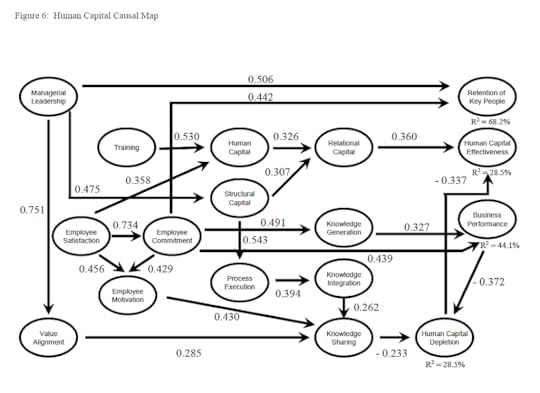 Community, Conferences, and PresentationsSIKM Leaders Community PostsMcMaster World CongressKMWorld2000 Closing Keynote: All Aboard! Take a Knowledge Journey2001Session E202: KM Practices in Government: A Canadian PerspectiveSession E302: Human Capital ROI: KM & HR Driving Business Results — Slides2002 Session D302: IC What You See: The Intellectual Capital of Nations2004 Session A201: Intangible Assets and Enterprise Risk Mitigation — with Cindy Gordon — SlidesList from ChatGPT“The Concept of ‘Ba’: Building a Foundation for Knowledge Creation” (2005) — a presentation delivered at the 6th International Forum on Knowledge Asset Dynamics.“The Future of Knowledge Management” (2006) — a presentation delivered at the Asia Pacific KM Conference.“Measuring and Managing Intellectual Capital: Best Practices, Models and Benchmarks” (2007) — a presentation delivered at the 2nd International Conference on Intellectual Capital and Knowledge Management.“Knowledge Management Lessons Learned: The Care and Feeding of Knowledge Workers” (2011) — a presentation delivered at the World HRD Congress.“Intellectual Capital: The State of the Field” (2018) — an article co-authored with Ante Pulic and Marta Orviska, published in the Journal of Intellectual Capital.List from BardBontis, N. (2000). Intellectual capital: A key driver of sustainable competitive advantage. Presentation at the World Business Congress, Brisbane, Australia.Bontis, N. (2001). Measuring intellectual capital: A review of the literature and a proposed framework for measuring knowledge stocks and flows. Presentation at the European Academy of Management Conference, Athens, Greece.Bontis, N. (2002). National intellectual capital index: Measuring knowledge assets of nations. Presentation at the World Knowledge Forum, Seoul, South Korea.Bontis, N. (2003). Intellectual capital and organizational performance: A review of the empirical literature. Presentation at the Academy of Management Annual Meeting, Seattle, WA.Bontis, N. (2004). Creating a knowledge-based economy: The role of intellectual capital. Presentation at the World Economic Forum, Davos, Switzerland.KM 101 Workshop
Community, Conferences, and PresentationsSIKM Leaders Community PostsMcMaster World CongressKMWorld2000 Closing Keynote: All Aboard! Take a Knowledge Journey2001Session E202: KM Practices in Government: A Canadian PerspectiveSession E302: Human Capital ROI: KM & HR Driving Business Results — Slides2002 Session D302: IC What You See: The Intellectual Capital of Nations2004 Session A201: Intangible Assets and Enterprise Risk Mitigation — with Cindy Gordon — SlidesList from ChatGPT“The Concept of ‘Ba’: Building a Foundation for Knowledge Creation” (2005) — a presentation delivered at the 6th International Forum on Knowledge Asset Dynamics.“The Future of Knowledge Management” (2006) — a presentation delivered at the Asia Pacific KM Conference.“Measuring and Managing Intellectual Capital: Best Practices, Models and Benchmarks” (2007) — a presentation delivered at the 2nd International Conference on Intellectual Capital and Knowledge Management.“Knowledge Management Lessons Learned: The Care and Feeding of Knowledge Workers” (2011) — a presentation delivered at the World HRD Congress.“Intellectual Capital: The State of the Field” (2018) — an article co-authored with Ante Pulic and Marta Orviska, published in the Journal of Intellectual Capital.List from BardBontis, N. (2000). Intellectual capital: A key driver of sustainable competitive advantage. Presentation at the World Business Congress, Brisbane, Australia.Bontis, N. (2001). Measuring intellectual capital: A review of the literature and a proposed framework for measuring knowledge stocks and flows. Presentation at the European Academy of Management Conference, Athens, Greece.Bontis, N. (2002). National intellectual capital index: Measuring knowledge assets of nations. Presentation at the World Knowledge Forum, Seoul, South Korea.Bontis, N. (2003). Intellectual capital and organizational performance: A review of the empirical literature. Presentation at the Academy of Management Annual Meeting, Seattle, WA.Bontis, N. (2004). Creating a knowledge-based economy: The role of intellectual capital. Presentation at the World Economic Forum, Davos, Switzerland.KM 101 Workshop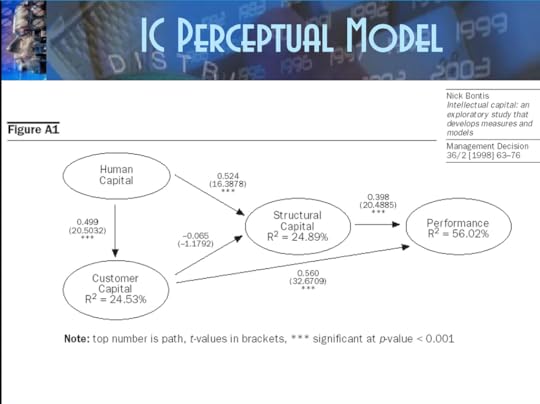
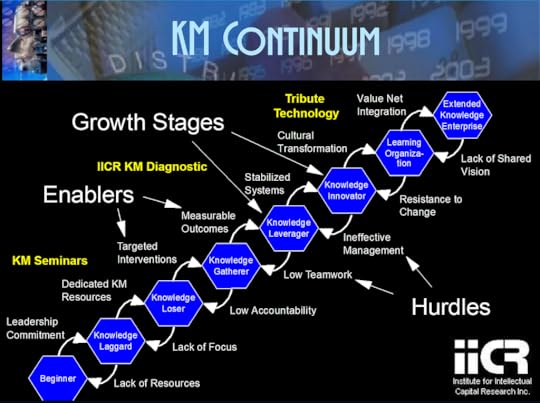
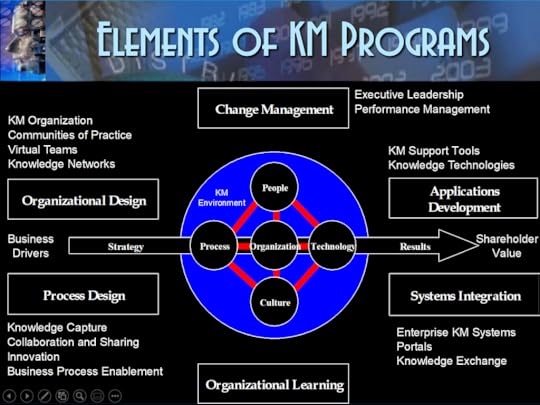
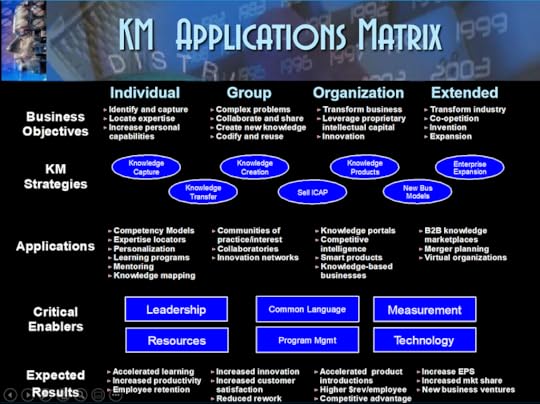
 Podcast and InterviewPodcast: Knowledge Worker ProductivityInterviewed by Haegwan KimVideosYouTubeTips to Manage Information Overloadhttps://medium.com/media/55d8af57a418aa5f06912541a28875a7/hrefInvesting in Disruptive Technologyhttps://medium.com/media/cc1db7ff8f94b5608ccb64be806495e0/hrefCollaboration in Teamshttps://medium.com/media/ee33a71f47997fa1c36c7f21e5fa2bcb/hrefMaster Time Allocationhttps://medium.com/media/fc879dc81893db90e89fe929112991ba/hrefThe Key to Success with a Liquid Workforcehttps://medium.com/media/01fa307d9fbf957fedd94709d1daa4c5/hrefHow Technology Affects Our Work-Life Balancehttps://medium.com/media/189a2efa453becc51c426d83cd604256/hrefBooksInformation Bombardment: Rising Above the Digital Onslaught
Podcast and InterviewPodcast: Knowledge Worker ProductivityInterviewed by Haegwan KimVideosYouTubeTips to Manage Information Overloadhttps://medium.com/media/55d8af57a418aa5f06912541a28875a7/hrefInvesting in Disruptive Technologyhttps://medium.com/media/cc1db7ff8f94b5608ccb64be806495e0/hrefCollaboration in Teamshttps://medium.com/media/ee33a71f47997fa1c36c7f21e5fa2bcb/hrefMaster Time Allocationhttps://medium.com/media/fc879dc81893db90e89fe929112991ba/hrefThe Key to Success with a Liquid Workforcehttps://medium.com/media/01fa307d9fbf957fedd94709d1daa4c5/hrefHow Technology Affects Our Work-Life Balancehttps://medium.com/media/189a2efa453becc51c426d83cd604256/hrefBooksInformation Bombardment: Rising Above the Digital Onslaught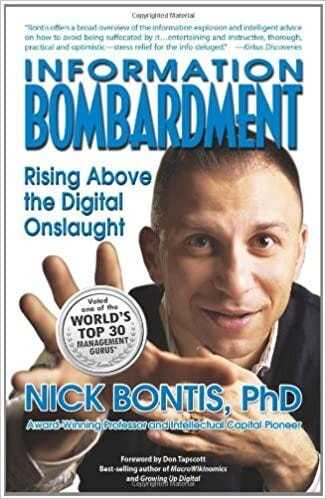 Models of Intellectual Capital
Models of Intellectual Capital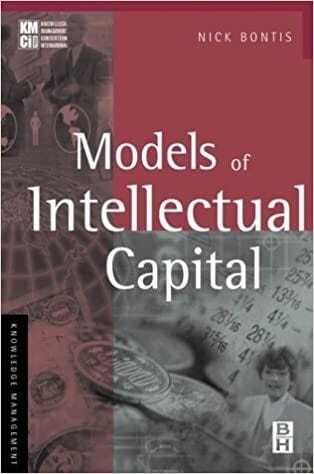 E-Business Essentials: Special Issue of the Quarterly Journal of Electronic Commerce (editor and chapter co-author)
E-Business Essentials: Special Issue of the Quarterly Journal of Electronic Commerce (editor and chapter co-author)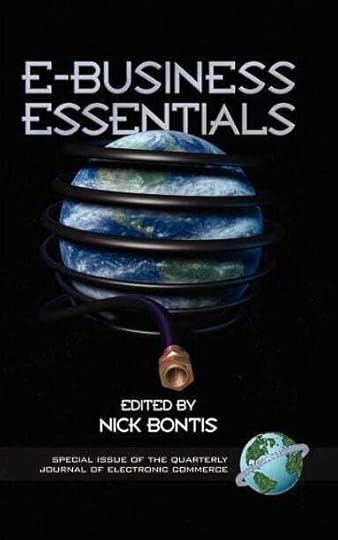 Digital State at the Leading Edge with Sandford Borins, Kenneth Kernaghan, David Brown. Perri 6, and Fred Thompson
Digital State at the Leading Edge with Sandford Borins, Kenneth Kernaghan, David Brown. Perri 6, and Fred Thompson World Congress on Intellectual Capital Readings (editor and chapter author)
World Congress on Intellectual Capital Readings (editor and chapter author) The Strategic Management of Intellectual Capital and Organizational Knowledge: A Collection of Readings edited with Chun Wei Choo
The Strategic Management of Intellectual Capital and Organizational Knowledge: A Collection of Readings edited with Chun Wei Choo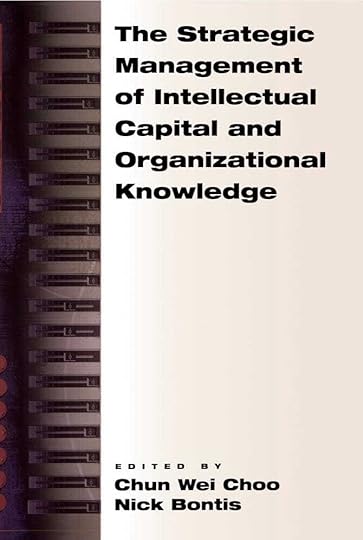 Book ChaptersKnowledge Management and Business Model Innovation edited by Yogesh Malhotra — Chapter 16: Managing Organizational Knowledge by Diagnosing Intellectual Capital: Framing and Advancing the State of the FieldEffective Knowledge Management Systems in Modern Society edited by Murray Jennex — Chapter 12: Practical Relevance of Management Research: The Role of Doctoral Program Graduates with Madora Moshonsky and Alexander Serenko[image error]
Book ChaptersKnowledge Management and Business Model Innovation edited by Yogesh Malhotra — Chapter 16: Managing Organizational Knowledge by Diagnosing Intellectual Capital: Framing and Advancing the State of the FieldEffective Knowledge Management Systems in Modern Society edited by Murray Jennex — Chapter 12: Practical Relevance of Management Research: The Role of Doctoral Program Graduates with Madora Moshonsky and Alexander Serenko[image error]
April 14, 2023
The Five Cs of KM: Connect Part 4 — External Users
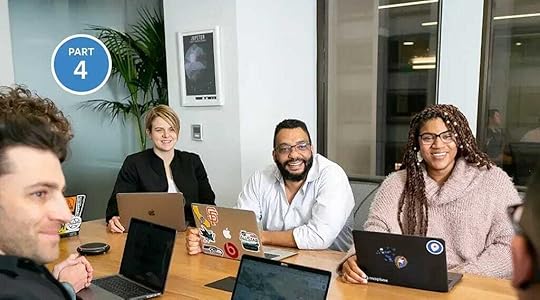
In In Parts 1, 2, and 3 of this series, I discussed three types of connection. This fourth and final part covers connecting with external users and giving them access to internal systems.
Providing external access is often overlooked as a knowledge sharing enabler. Connecting users outside an organization’s firewall to selected websites, team spaces, and systems enables collaboration with retirees, vendors, and external users who would otherwise be blocked from the internal network. Doing so requires technical, security, and legal elements to be put in place, but can be very beneficial.
Extranets are intranets that can be partially accessed by authorized outside users, enabling businesses to exchange information over the Internet securely. Extranets are controlled private networks that allow partners, vendors, suppliers, and an authorized set of customers to access a subset of the information accessible from an organization’s intranet.
In The Wealth of Knowledge: Intellectual Capital and the Twenty-first Century Organization by Thomas Stewart, in chapter 5, pages 85–87, the following key elements of a KM program are defined based on the experience of Steve Denning at the World Bank:
communities of practiceplace (online presence for the communities)help deskYellow Pages (who-knows-what directory)primer (FAQ)knowledge artifacts (records of previous projects, emphasizing best practices and lessons learned)bulletin boarddoorway (a provision for outside access)The final item, doorway, is often overlooked as an enabler for knowledge sharing to occur. Here are three examples of why external access can be valuable to an organization:
There is increasing concern about the loss of valuable knowledge as the workforce ages and Baby Boomers retire. Many of these retirees are willing to continue to share the knowledge they have gained over many years of experience. To do so, they need to be given access to community tools such as portals, team spaces, and threaded discussions. Providing this access poses minimal security risks and offers great benefits in ongoing contributions from the most experienced community members.
Vendors need access to effectively support their products and services inside the organization. Giving them access will greatly enhance the success of the vendor relationship. And vendors can contribute their knowledge about their products and services to communities within the organization if they are allowed to do so.
Other external users may also be able to share knowledge as extended community members. They can benefit from having access to problem resolution knowledge bases so they can solve their own problems, library assets so they can directly access what they need, and circulation systems so they can stay current on the status of requests without the need to contact a service desk.
Dealing with each of these opportunities in a way that maintains required levels of security, protects intellectual property, and enables the right level of access can be tricky. But it is worth creating the people, process, and technology mechanisms to make it work. The technology elements include providing gateways, secure servers, and identity management hardware and software.
Use CasesHere are possible uses for providing external access to internal systems.
Prospects: Interact with those who can help persuade them to become customers.Customers: Participate in their projects, monitor delivery of their purchases, get support from those best able to provide it, and support one another.Partners: Access information needed to support the partnership, collaborate with the right people, and directly use relevant business systems.Vendors, Suppliers, and Providers: Deliver support for products being used, see problems for themselves, and interact with one another.Analysts: Access appropriate information to help develop and update analyses of the company and its offerings.Contractors: Use time reporting, expense reporting, scheduling, project management, and team collaboration systems as if they were employees.Collaborators: Suggest improvements, collaborate on initiatives, and deliver innovations.Alumni and Retirees: Participate in communities, answer questions, and provide support.Candidates and Recruits: Interact with interviewers, hiring managers, and one another.Officials, Reviewers, and Auditors: Access relevant systems and databases, interact with appropriate contacts, and communicate progress and results.When not to provide external accessExternal access to highly confidential collaboration and communication, internal-only projects, or internal Enterprise Social Networks (ESNs) should not be provided. This last one (ESNs) is controversial and caused an uproar when one ESN provider announced that external participation was being enabled for its product.
The problem with doing so is that an ESN is generally thought to be an internal-only network. The presence of external participants could be unnoticed by some members, leading to potentially damaging revelations of confidential information to non-employees. This should be avoided.
This concludes the third series on The Five Cs of KM. Please register for next week’s webinar on the third C: Connect, where I will present on the topics covered in this series. And get ready for the next series of blog posts where I will discuss the fourth C: Collaborate.
 The Five Cs of KM[image error]
The Five Cs of KM[image error]
April 7, 2023
The Five Cs of KM: Connect Part 3 — Content to Content
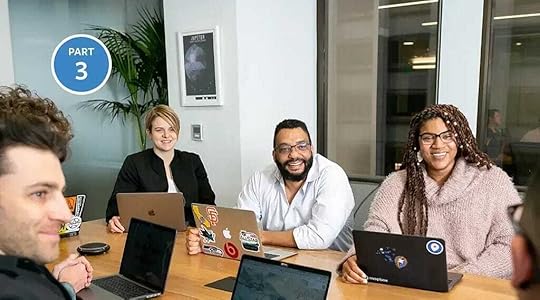
In Parts 1 and 2 of this series, I discussed connecting people to people and people to content. This part covers connecting content to content.
Connecting content to content means ensuring that when users view one knowledge asset, they are able to see all related items. This type of connection is intended to expand the horizons of users so that they see beyond a single document or other resource to take in other content that may also be valuable. In this way, their knowledge sources are extended and diversified.
The additional assets should be displayed to users so that they see the connections. One goal is to offer an integrated view of all knowledge assets for a specific topic. A second goal is to prevent users from downloading a single document and being unaware of other potentially useful ones. And a third goal is to help users when they look up a single term in an index by showing them related terms.
Connecting content to content can be accomplished by creating a taxonomy, a thesaurus, and links between content.
TaxonomyA taxonomy is a particular classification arranged in a hierarchical structure that can be used to organize information so that it can be readily found through navigation, search, and links between related content. A taxonomy formalizes the hierarchical relationships among concepts and specifies the term to be used to refer to each. It prescribes structure and terminology. Examples of taxonomies include the Dewey Decimal System for libraries and the organization of living things (Kingdom, Phylum, Class, Order, Family, Genus, Species) for biology.
Once you have a taxonomy you can create a controlled vocabulary with a picklist containing the official terms in the defined hierarchy. These terms can then be applied as metadata to any of the content captured in knowledge repositories. Creating and maintaining a standard taxonomy and providing an easy way of tagging content make it easy for users to find just the relevant content they need without seeing too much or too little.
I went through a tagging exercise in a community that I lead, the SIKM Leaders Community. I went back to the old threaded discussions and added hashtags to each one using a controlled set of topics. This allows me to easily respond to people asking new questions by referring back to previous threads on the same topic. For example, if a member asks about maturity models, I can provide a single link to the #maturity hashtag. The community has unique hashtags for each important topic and all of the content in the discussions is tagged. This is a powerful capability to offer to the members.
 SIKM Leaders Community HashtagsThesaurus
SIKM Leaders Community HashtagsThesaurusA thesaurus provides an initial entry point, in the user’s terms, to the structured language of the taxonomy used to index content. A list of synonyms can be maintained in a thesaurus, which should be helpful if someone is looking for content using one term, but it was tagged using a related but different term.
A good way to augment an index used for navigation is to maintain a thesaurus as part of that index. To do so, list all the words that a user might think of for a given topic, i.e., that are synonyms, and add them to the index with brief text or a link redirecting to the main topic. Maintaining synonyms is an important way of helping people to find things regardless of how they view a topic. They will have the option of finding content in the way they view it, not just the way the system defines it.
Whenever confusion over terminology is possible, an effective method for resolving it is disambiguation. In Wikipedia, a disambiguation page lists several different variations of a term, adds a brief description of each one to help differentiate them, and links to the appropriate page for each one. If a term has multiple meanings, use disambiguation to help guide users to the right content.
For example, the term AI has two different meanings in the context of knowledge management. If a user enters “AI” in a search box, or clicks on AI in tag cloud, that should lead to a screen that lists both. It might display “AI: Artificial Intelligence or Appreciative Inquiry’ with each term linked to the appropriate content. Or it might ask the question “Did you mean Artificial Intelligence or Appreciative Inquiry?” and then redirect accordingly.
LinksThe most explicit way to connect content to other relevant content involves embedding direct links, either hotlinks in the main body of the text or a section at the end labeled “See also.” Anticipating what else users may be looking for and guiding them to it can make things much easier for them.
Whenever I write an article or blog post, the last section is “Additional Resources” with links to related articles. This provides even greater depth, variety, and diversity of thinking than I can offer just from my own writing. In a sense, the links extend the article by linking to other content. Readers don’t have to go search and discover other content on their own because direct links drop them off where they need to be.
The same process can be used with discussions. By clicking on the tags added to any thread, community members can read all of the previous discussions on that same topic. As a community manager, I often post links to previous discussions in new ones. And linking from a document to a discussion, or from a discussion to a document, can enhance the value of both the document and the discussion.
In Part 4 of this series, I will discuss connecting with external users.
 The Five Cs of KM[image error]
The Five Cs of KM[image error]



